#ryukyu shinto
Photo
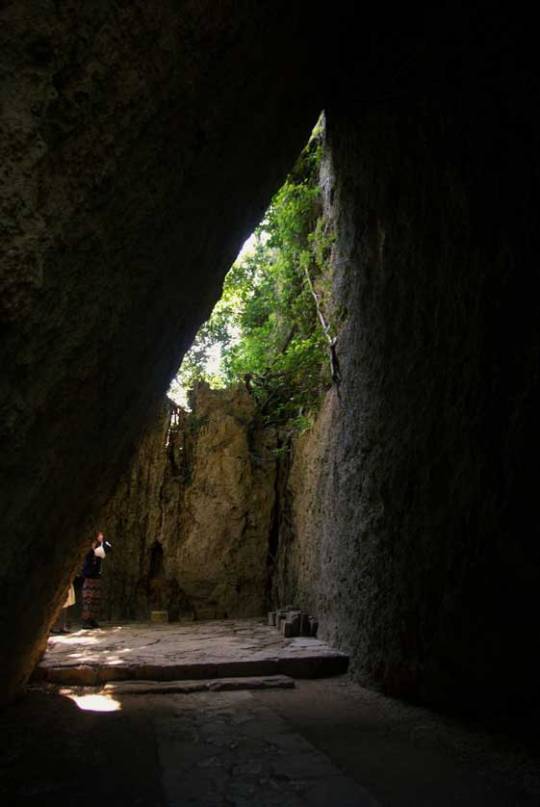
Legends and myths about trees
Utaki worship in Ryukyu Shinto - Forest where the gods descend in Ryukyu Shinto
Ryukyu Shinto is a polytheistic religion that has been practised mainly in ancient Ryukyu and the Ryukyu Kingdom (Ref). It lacks written scriptures, specific doctrines or founders, and is an animistic and ancestral religion of mythology and nature worship.
Utaki are places where the mythical deities of the Ryukyu Islands exist or visit, and where ancestral deities are worshipped. It is a central facility in local rituals and still attracts many worshippers as a sanctuary that protects the area.
In Ryukyu Shinto, it is women who serve the gods. Since ancient times, women were considered to have stronger spiritual powers than men in the Ryukyus, and the noro, who served the gods, and the yuta, who were shamans, were also women. So, it was completely off-limits to the public, especially men, during the Kingdom period, and even the king had to change into women's clothing to enter the sanctuary. Even today, most of them only allow men to enter up to a certain area.
Many Utaki are forest spaces, springs or rivers, and sometimes the island itself. Some Utaki have a stone monument called Ibe or Ibi stone in the centre of the space, but this is originally a sign to which the deity descends and is not a sacred body in the strict sense of the word (although in many places it is treated as a sacred body).
Among others, the Sefa Utaki, the highest sacred site, is believed to be a Utaki from the 15th-16th century, during the reign of King Shō Shin, the second Shō dynasty of the Ryukyu Kingdom. “Sefa” means "highest" and "Sefa Utaki" means "highest Utaki", which is a common name. The official name of the deity is "Kimigataki, Syugataki-no-Ibi (meaning sanctuary where the lord descends)".
Later, following the invasion of Satsuma (now Kyushu, Japan), the original beliefs and ancient colours of the theocracy were gradually weakened and dismantled by reforms that promoted modernisation.

木にまつわる伝説・神話
御嶽(うたき) 〜 琉球神道における神が降臨する森
琉球神道は、古琉球および琉球王国(参照)を中心に信仰されてきた多神教宗教である。固有の教典や具体的教義、開祖を欠いており、神話、自然崇拝のアニミズム的かつ祖霊崇拝的な宗教である。
御嶽(うたき) は琉球神話の神が存在、あるいは来訪する場所であり、また祖先神を祀る場でもある。地域の祭祀においては中心となる施設であり、地域を守護する聖域として現在も多くの信仰を集めている。
古来、琉球では女性の方が男性よりも霊力が強いと考えられており、神に仕えるノロやシャーマンであるユタも女性であった。そのため、王国時代は完全に一般人、特に男性の立ち入りは厳禁とされ、王であっても女性の衣装に変えて入域しなければならないほどの聖域だったと云われている。現在でもその多くが一定区域までしか男性の進入を認めていない。
御嶽(うたき) の多くは森の空間や泉や川などで、島そのものであることもある。御嶽(うたき) によっては空間の中心にイベあるいはイビ石という石碑があるが、これは本来は神が降臨する標識であり、厳密な意味でのご神体ではない (ご神体として扱われているところも多い)。
中でも、最高の聖地である斎場御嶽 (せーふぁーうたき) は、15世紀-16世紀の琉球王国・尚真王時代の御嶽であるとされる。「せーふぁ」は「最高位」を意味し、「斎場御嶽」は「最高の御嶽」ほどの意味となり、これは通称である。正式な神名は「君ガ嶽、主ガ嶽ノイビ (最高の神が降臨する聖域の意)」という。
その後、薩摩 (現在の九州) の侵入を受けて以後、近代化を進める改革によって、神権政治の本来の信念と古来の色彩は、次第に弱まり、解体されていった。
#trees#tree legend#tree myth#utaki#sefa utaki#ryukyu shinto#mythology#legend#ryukyu kingdom#okinawa#gods descend forest#nature#tradition#art#sharmans#spiritual powers
150 notes
·
View notes
Text
EAST ASIAN RESOURCES
The Anthropological Masterlist is HERE.
East Asia is an Asian region on the eastern side of the Asian continent.
AINU ─ “The Ainu people are a Northern Asian people. They are native to Hokkaido island and the Kuril islands.”
─ Ainu Culture
─ Ainu Culture
─ Ainu Dictionary
BURYAT ─ “The Buryat are a Mongolian people. They are native to the Republic of Buryatia in Russia.”
─ Buryat Dictionary (in Russian)
CHINA ─ “The Chinese, or Huaren, people are an East Asian people that share the Chinese culture. They are native to China.”
─ Chinese Mythology
─ Chinese History
─ Chinese Dynasties
JAPAN ─ “The Japanese people are an East Asian people that share the Japanese culture. They are native to Japan.”
─ Japanese Information
─ Japanese Language
─ Japanese Calligraphy
KOREA ─ “The Korean people are an East Asian people. They are native to the Korean Peninsula.”
─ Korean Customs
─ Korean History
─ Korean Language
MACAU ─ “The Macau people refers to anyone that is from Macau. Those of Portuguese descent are referred to as ‘Macanese.’”
─ Macau Information
MANCHU ─ “The Manchu people are a Tungusic people. They are native to China.”
─ Manchu History
─ Manchu Language
MONGOLIA ─ “The Mongolian, or Mongol, people are an East Asian people. They are native to Mongolia, Inner Mongolia, and the Buryatia Republic.”
─ Mongolian Art
─ Mongolian Texts (in German)
─ Mongolian History
RYUKYU ISLANDS ─ “The Ryukyuan, or Loochooan, people are an East Asian people. They are native to the Ryukyu Islands, between the Kyushu island of Japan and Taiwan.”
─ Okinawan Folktales (in Japanese)
─ Ryukyuan History
─ Ryukyuan Languages
SHINTO ─ “Shinto, or Shintoism, is an East Asian religion. It originated in Japan.”
─ Shinto Information
─ The Kojiki
─ The Nihon Shoki
78 notes
·
View notes
Text
destruction as a means for healing
there's very interesting parallels between watatsumi island and scaramouche.
there's so much i need to explain regarding lore and buddhism to understand how I'm almost giving up, but i really like the idea overall, so we persevere.
buddhism is divided into three branches. mahayana is the one that spread to japan and syncretized with shinto
inazuma's narratives take inspiration from japanese mahayana buddhism (obviously), especially for characters like ei and to a lesser degree kazuha
watatsumi was inspired on ryukyu kingdom (i wanna complain about this in detail but not today) who had their own religion, most closely related to shinto. they did receive foreign influence, but the pattern im tracing is only in terms of the themes, not implying buddhism is directly tied to its culture
the goal of buddhism is basically to meditate ur way out of the cycle of reincarnation. the world is illusory and ur trapped in it because u cling to ur suffering (im simplifying it), so ur supposed to follow the doctrines and practices in order to integrate them to ur life in a way that it becomes natural.
things like ei quelling her desires or being against visions or becoming disossiated from her sense of self are all nods to these buddhist principles. so is kazuha choosing to let go of his pain and burdens (material and emotional attachments) in order to live with inner peace.
on the other hand, we have watatsumi and scaramouche who do anything but. their lives are defined by the sins of their pasts and the resentment they carry with them.
watatsumi descend from enkanomiya, and i need to point out this pattern:
they were abandoned by a god (the primordial one)
then they were granted divine knowledge (from istaroth)
they used this knowledge to create technology (aberaku built the artificial sun, helios)
they turned this technology into a divine object of worship (the political class convinced their people helios was a real god and began the corrupt ruling of the sun children)
they suffered until another god helped them out of compassion (orobashi agreed to be their god and took them to the surface)
now read those again with scaramouche in mind.
it is curious then, that their paths would cross during the inazuma chapter via the distribution of delusions. (convenient sidenote, the concept of delusion is the source of evil in buddhism)
watatsumi feels a lot of resentment against narukami for killing their god. so much so, that they were willing to use delusions which drained their life force in order to defeat them, and even after the war is over there are some resistance soldiers who wont let go of their resentment.
the delusions here are a key element, since they were literally made with the remains of their god. and scaramouche was the one tasked with distributing the delusions. the allegory is so in ur face its kinda hysterical.
now heres where it gets fun: the remains of orobashi are the source of the problems scaramouche faced in the past. tatarasuna was built to smelt swords with jade steel, which is made from crystal marrow extracted from orobashi's skeleton. and the illness that takes the life of the little child later is caused by the tatarigami, the surviving resentment of orobashi.
(COME ON)
these two narratives are so so closely tied its impossible for it not to be intentional. and u might ask ok but whats the point then, and to that i can offer:
mahayana buddhism was made as an alternative to theravada buddhism, and then vajrayana buddhism was created from mahayana buddhism. the differences dont matter much for the context of this post, in simple words vajrayana focuses on tantric practices and rituals. in mahayana u cultivate ur path out of suffering with meditation, and in vajrayana u add tantras and rituals to that meditation.
its probably not as simple as this, but mahayana sort of centers the worship on compassionate bodhisattvas (deities who have delayed their enlightment to help humans), and even though they all have the same symbols, there might be a bit more emphasis on wrathful bodhisattvas in vajrayana buddhism. overall these deities are idealized symbols, ur not meant to be them, they are symbolizing a virtue (i assume??).
whats important is a branch of vajrayana did make it into japan, becoming shingon buddhism, which centered its worship around one key wrathful bodhisattva: acala, also known as fudou in japanese. this is basically a symbol of enlightment through destruction. he's a deity that destroys ur pain and suffering, ur obstacles for enlightment. obviously its symbolic, but the feeling and vibes it invokes are quite different from the compassionate symbols of mahayana.
there is one ritual for fudou where things are offered to fire, so its basically purification through burning, through destruction and renewal of the self.
aka:
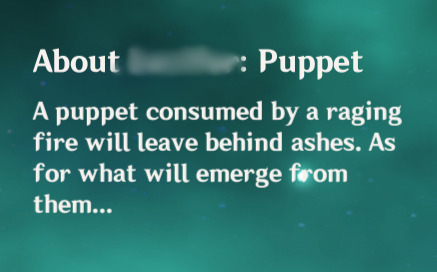
scara/wanderer's design is based off a shugendo monk, a super syncretic religion made of everything that reached japan. but, they have special worship for fudou and the fire ritual.
scara literally faces his suffering and sins (as in, the accumulation of karma in buddhist concepts) in the form of shouki no kami, and he fucking obliterates it just as he gains his vision. this is healing through destruction, at its least symbolic form, reaching enlightment not through meditation and not through "peaceful" methods of quelling emotions, but through goddamn rightful rage. (i am screaming this into the void it makes me nuts)
in a less literal (and exciting) way, kokomi also finds a way to redirect the resentment of the watatsumi soldiers into a path of self advancement. she doesnt punish them for their desire to take this resentment into action against the shogunate, instead she lets them form a special division where they will train not for revenge, but for the protection of their people. the rage is not quelled, the violence is not stopped, just redirected into actions for collective and personal well being. which is what ur supposed to do in buddhism, as far as i understood (the concept of chanda, and all that)
anyway, yeah, healing through violence. i love scaramouche
84 notes
·
View notes
Text


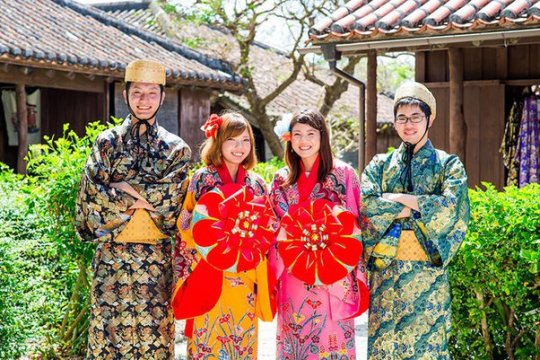
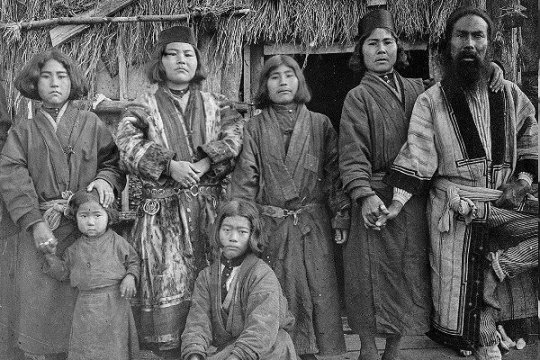

How many ethnicities are in Nipon(japan)?
Yamato Japanese 123,900,000
Ryukyuan Japanese1,300,000
Chinese 650,000
Korean 525,000
The Yamato people (大和民族, Yamato minzoku, literally "Yamato ethnicity") or the Wajin (和人, Wajin, 倭, literally "Wa people") is a term to describe the ethnic group that comprises over 98% of the population of Japan. Genetic and anthropometric studies has showed that the Yamato are an admixture of the migratory Kofun and Yayoi, who arrived from mainland East and Southeast Asia via the Korean Peninsula, as well as the indigenous Jōmon that were already living on the Japanese archipelago for thousands of years prior.
It can also refer to the first people that settled in Yamato Province (modern-day Nara Prefecture). Generations of Japanese historians, linguists, and archeologists have debated whether the word is related to the earlier Yamatai (邪馬臺). The Yamato clan set up Japan's first and only dynasty. The clan became the ruling faction in the area, and incorporated native Japanese, Chinese and Korean migrants. The clan leaders also elevated their own belief system that featured ancestor worship into a national religion known as Shinto.

The Ryukyuan people (Okinawan: 琉球民族 (るーちゅーみんずく), romanized: Ruuchuu minzuku or どぅーちゅーみんずく, Duuchuu minzuku, Japanese: 琉球民族/りゅうきゅうみんぞく, romanized: Ryūkyū minzoku, also Lewchewan or Loochooan)[8] are a Japonic-speaking East Asianethnic group native to the Ryukyu Islands, which stretch between the islands of Kyushu and Taiwan.[9] Administratively, they live in either the Okinawa Prefecture or the Kagoshima Prefecture within Japan. They speak one of the Ryukyuan languages, considered to be one of the two branches of the Japonic language family, the other being Japanese and its dialects. Hachijō is sometimes considered by linguists to constitute a third branch
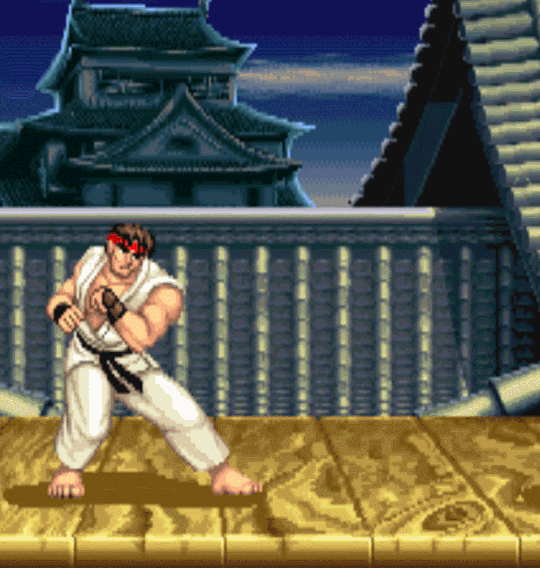
#ryukyuan#nippon#nipon#nihon#japan#kemetic dreams#yamato people#asian#east asian#east asians#ethnic diversity
7 notes
·
View notes
Text
Burgen
Natürlich müssen in Okinawa auch diverse mittelalterliche Burgen besucht werden!
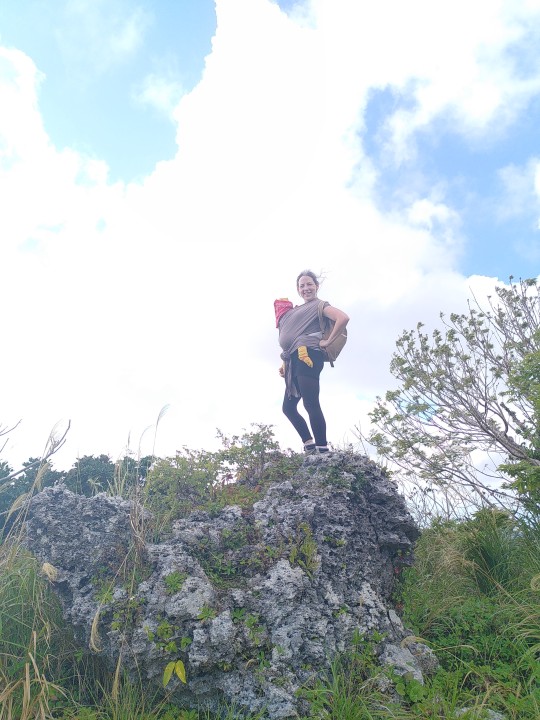
Wer Eastern kennt, oder Samurai- oder Ninja-Filme, denkt bei japanischen Burgen wahrscheinlich eher an hübsche, aber zierliche Holzschlösschen mit Papierwänden, bei denen man sich fragt, welche Belagerer sich davon beeindrucken lassen sollten.
Aber gerade hier auf Okinawa konnten die mittelalterlichen Feudalherren auch imposante Steinburgen errichten. Aber auch besagte Prunkschlösser gibt es hier.
Der erste Burg-Besuch war erstmal ein Reinfall. Von der Burg war nichts mehr übrig, an seiner Stelle stand aber ein hübscher Shinto-Schrein.

Itokazujo
Unser erster richtiger Burgbesuch war darum die Burgruine von Itokazu, auf japanisch Itokazujo (io heißt Burg). Die Burg wurde bereits prominent beworben im Werbefernseher des Gemeindebusses.
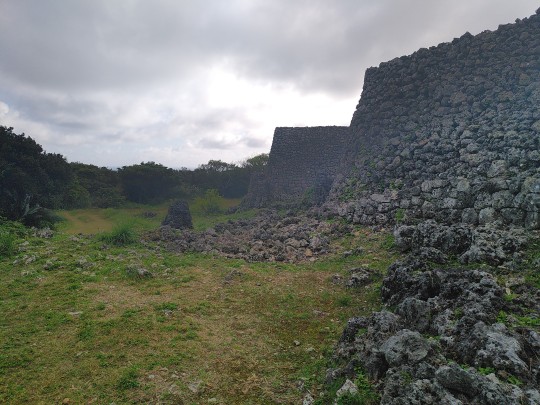
Die Busstation ist ein ganzes Stück entfernt, so dass wir zwischen den Zuckerrohr-Feldern des agrarischeren Teils Nanjos entlang wandern. Als die Burg ausgeschildert ist, bietet sich uns ein unerwartetes Bild: ein massives japanisches Küstengeschütz aus dem zweiten Weltkrieg.
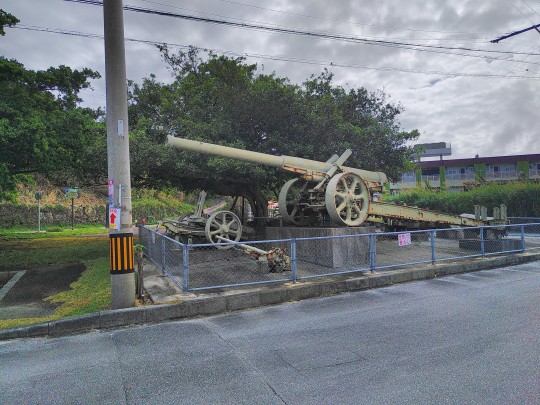
Hier befindet sich eine weitere Attraktion von Nanjo (unserer Heimatgemeinde): eine langläufige natürliche Höhle. Was hat das mit dem Zweiten Weltkrieg zu tun? In der Schlacht von Okinawa bot die Höhle Zivilist*innen Schutz, vor allem aber wurde sie von der japanischen Armee als Feldlazarett benutzt. Entsprechend viel menschliches Leid hat die Höhle gesehen. Heute befindet sich über der Höhle ein Kriegs-Museum.
Aber wir wollen ja zum mittelalterlichen Kriegsschauplatz. Die im 14. Jhdt. errichtete Itokazu-Burg wurde nämlich tatsächlich Teil eines Krieges. Dort residierten die Herrscher des Tamagusuku-Fürstentums, den Königen des Nanzan-Königreichs auf Okinawa treu ergeben. Das Nanzan-Königreich und dabei auch das Tamagusuku-Lehen wurde schließlich 1429 vom Herrscher des Königreichs Chuzan erobert. Damit wurden alle Reiche der Inselkette unter einer Macht vereint und das Ryukyu-Königreich begründet.
Bald treffen wir auf den ersten, imposanten Wall, der den Zugang den Berg hinauf bewacht.

Dahinter folgt noch eine weitere ringförmige Mauer, an den ehemalige Tore und Türme erkennbar sind.



Besonders beeindruckt hat uns, wie passgenau die Kalkstein-Brocken bearbeitet waren. Die Mauern kamen so ganz ohne Kitt aus. Wehrgänge, Treppen oder andere funktionelle Bestandteile konnten wir an der Mauer nicht erkennen. Vielleicht waren sie früher noch mit Holzaufbauten versehen.
Wie alle anderen Burgen auch, ist diese natürlich hoch gelegen und uns eröffnet sich ein toller Blick auf das Meer und die Oujima-Insel.

Hinter dem zweiten Wall erstreckte sich eine große Wiese voller Grundmauern. Die Ausmaße waren die einer mittelgroßen mittelalterlichen Stadt, aber die Mauern waren auffällig langgezogen, also handelte es sich wohl eher um noch weitere Wehranlagen von eindrucksvoller Größe.
Nakagusukujo
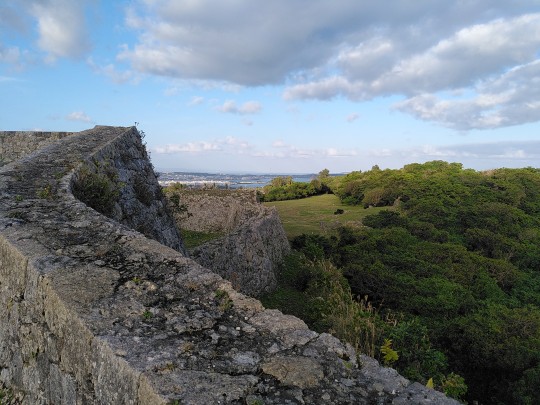
Die Nakagusukujo-Burg hätten wir einmal fast aus Versehen angesteuert, als wir mit dem Auto auf dem Weg zum Mangrovenwald waren und nach einem Zwischenstopp für den mürrischen Levin gesucht hatten. Da fiel uns die "Archäologische Ausgrabungsstätte" ins Auge, aber da wir nicht ahnten, dass es sich um die zweitgrößte Burg Okinawas handelt, hatten wir stattdessen einen Flohmarkt besucht.
Zum Glück ist uns unser Versäumnis später aufgefallen und wir haben uns gestern auf den Weg gemacht. Da wieder keine Bushaltestelle in der Nähe war, mussten wir ein ganzes Stück hinlaufen. Diesmal aber steil bergauf, von der Küste bis ganz hoch auf den Berg steigen - eine Dreiviertelstunde und ~100 Höhenmeter Weg.
Oben schließlich angekommen die Ernüchterung: Es kostet Eintritt und hat nur noch eine Dreiviertelstunde offen. Aber jetzt sind wir ja schon mal hoch gelaufen. Als Belohnung bekommen wir eine Fahrt mit einem coolen Buggy direkt vor das Haupttor.
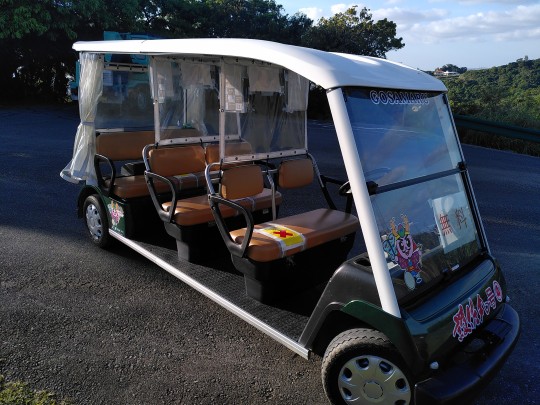

Die Burg teilt sich in vier innere Höfe und drei weitere Außenmauern auf. Vom ersten Hof ist kaum noch etwas übrig. Dafür bietet sie einen fantastischen Ausblick.

Aber die anderen drei Höfe sind erstaunlich gut erhalten und lassen erahnen, wie gut die Feste verteidigt werden konnte und wie viel Platz seine Bewohner*innen hatten.


Auch hier begegnen uns wieder die perfekt zurecht gehauenen Kalksteine.

Leider konnte all die Wehrhaftigkeit der Burg ihren Erbauer nicht retten. Der berühmte Fürst und Kriegsherr Gosamaru war es, der eben jenes Königreich Chuzan der vorherigen Burg unterwarf. Als Champion des neu gegründeten Ryukyu-Reichs wurde er später damit beauftragt, diese Nakagusuku-Burg zu errichten, um den benachbarten Fürsten Amawari in seine Schranken zu weisen, der Ambitionen auf den Königsthron hegte. Es gelang jedoch Amawari schließlich den König zu überzeugen, dass nicht er, sondern Gosamaru eine Revolte gegen den Thron plante, sodass die königliche Armee kommandiert vom gerissenen Amawari gegen die Nakagusuku-Burg auszog. Der Legende des tragischen Schicksals von Fürst Gosamaru zufolge, weigerte sich dieser gegen die königlichen Truppen zu kämpfen und beging rituellen Selbstmord. Amawaris Kabale jedoch flog bald auf und seine Burg Katsuren wurde ebenfalls vom König gestürmt und der Fürst hingerichtet. Gemunkelt wird, dass die ganze Scharade ein ausgeklügelter Plan des Königs selbst war, um sowohl den angesehenen Gosamaru, als auch den mächtigen Amawari aus dem Weg zu räumen.





Abgesehen von den Mauern gab es auch noch eine verwunschene Zisterne und eine Warnung vor Habu-Schlangen zu bewundern.
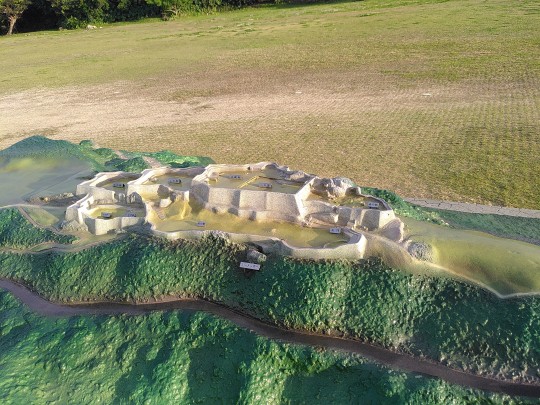
Shurijo
Heute waren wir schließlich in der größten und berühmtesten Burg Okinawas, in der eben jener König von Ryukyu und seine Familie residierten. Hier findet man endlich auch die typische japanische Prunkschloss-Architektur. Naja, oder auch nicht.

Die Burg wurde im 14. Jahrhundert nach der Einigung der Inselkette durch den ersten Ryukyu-König Shō Hashi gebaut und zwar um einen Pavillon herum, auf der Spitze des Berges. Über die Jahrhunderte sind mehrere Mauer-Ringe, ein Tempel, große Wohn- und repräsentative Gebäude und ein Teich hinzugekommen. Hier wurden Delegationen aus China und Japan empfangen, große Feste gefeiert, religiöse Rituale abgehalten und die Verwaltung des Ryukyu-Königreichs organisiert.
Nach der Meji-Restauration wurde das Königreich Ryukyu schließlich von Japan annektiert und der König von Ryukyu 1879 aus seinem Palast geworfen. Seitdem diente die Burg als Garnison der kaiserlichen Armee.


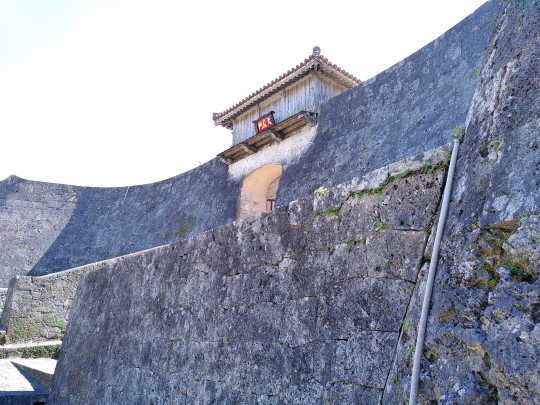
Auffällig ist natürlich wie toll alles erhalten und gepflegt ist. Der Grund dafür ist einfach: Zwar hat die Burg nie einer mittelalterlichen Belagerung standhalten müssen, dafür wurde sie aber im Zweiten Weltkrieg als Garnison genutzt. Entsprechend wurde die Burg von amerikanischen Bombern und Artillerie in der Schlacht von Okinawa dem Erdboden gleich gemacht.

In den 60ern begann Japan dann die gesamte Burg Stein für Stein wieder aufzubauen. Teilweise kann man in den Mauern noch gut sehen, welche ursprünglichen Mauerreste noch übrig waren und wo neue Mauern hochgezogen wurden. Bis heute ist der Neubau dieser Burg noch nicht abgeschlossen. Ausgerechnet die fantastische Pagode im Zentrum ist noch nicht fertig und wird von einer hässlichen Blech-Halle versteckt.
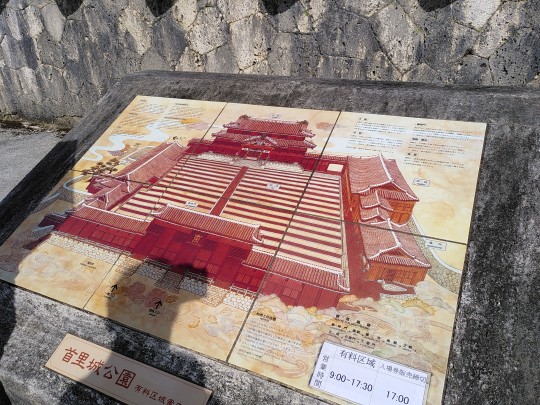
Auf jeden Fall können wir bezeugen, dass sie sich bei der Rekonstruktion der Burg unglaubliche Mühe machen. Im Innenhof konnten wir ein Dutzend Arbeiter*innen beobachten, wie sie mit anachronistischen Stößeln Original-Steine der Festung zerbröselten, damit daraus neue Steine für den Wiederaufbau der Burg geformt werden können.

Und auch die Shurijo-Burg belohnt uns mit einer tollen Aussicht, diesmal über die Hauptstadt Okinawas, Naha.

0 notes
Text
Japan - National Geographic Society
EPUB & PDF Ebook Japan | EBOOK ONLINE DOWNLOAD
by National Geographic Society.

Download Link : DOWNLOAD Japan
Read More : READ Japan
Ebook PDF Japan | EBOOK ONLINE DOWNLOAD
Hello Book lovers, If you want to download free Ebook, you are in the right place to download Ebook. Ebook Japan EBOOK ONLINE DOWNLOAD in English is available for free here, Click on the download LINK below to download Ebook Japan 2020 PDF Download in English by National Geographic Society (Author).
Description Book:
- Waterproof - Tear-Resistant - Travel MapExplore the Land of the Rising Sun with National Geographic's expertly researched Japan Adventure Map. The user-friendly design combined with unparalleled detail provides adventure travelers the ultimate tool for exploring this island nation. Coverage includes the four main islands of Hokkaido, Honshu, Shikoku and Kyushu, as well as the southeastern tip of the Korean Peninsula. Inset maps cover Okinawa and many of the other Ryukyu Islands. Some popular destinations include the cities of Tokyo, Kyoto and Nara, Mount Fuji, the Hiroshima Peace Memorial and Himeji Castle. The map is the perfect compliment to National Geographic's Japan Traveler Guide or any other guidebook.Hundreds of highlighted cultural, historical and recreational points of interest, including UNESCO World Heritage Sites, National Parks, botanical gardens, castles, churches, Buddhist temples, Shinto shrines, caves, waterfalls, hot springs, ski area and beaches, will guide you
0 notes
Text
Pokemon Worldbuilding Origins - The early modern era
Old, incomplete world-building based on fan-theory for unfinished fan project I really don't know where I was going with.
File: Modern Pokemon training had its origins in the traditional religion of Japan.doc
Created: 02/08/2017, 11:25:00
Modern Pokemon training had its origins in the traditional religion of Japan, Shinto. Much like Sumo, the first recognizable pokemon battles originated from in ritual battles or dances in which two pokemon fought on temple grounds. At the time, they were thought to be either, depending on region, species, and time period, animalistic embodiments of the elements, or creatures who have been blessed by the kami as their champions—in either case, they were regarded as essenctially kami themselves. And so, these ritual battles were kami battling kami, element fighting element, a ritual reflection of the balances of nature.
These battles were also found at the imperial court. Much like Sumo, it functioned both as entertainment for the emperor and high-ranking lords, public spectacle, and proof of strength of the warriors. Trainers would have to fund their travels for themselves and their kami. This contest was called kamiko no sechie, or "little-kami party". The nature
During the early Edo period, under the Tokugawa shogunate, pokemon battling developed as a form of public entertainment. The many local variations stabilized, standardized, and coalesced, with many of the modern traditions deriving from this stage.
By the time General Perry forced Japan out of isolationism, the formula of the pokemon battle had settled in the mainland Japan, although in the Ryukyu islands local dialects of pokemon battling were the rule and the norm. Nonetheless, the traditions of battling, maintained mostly by the traditional houses through constant internal petty conflicts and the preparation they required, fell slack as the traditional warrior houses were banned from the Army and Navy and most initiative was placed into building financial, rather than military, strength.
Come WWI.
Up till the First World War, Japan's warrior pokemon, like most other cultures, were disorganized, homegrown fighters, considered an offshoot of the human warrior trainer. Let us be clear, then, what happens after the feudal eras: Pokemon weaken.
During feudal eras, warrior households were the primary means by which elite soldiers (knights, samurai) were raised and trained for combat. This was more or less a collective effort, in addition to a master-apprentice effort. Likewise it was so for pokemon. Households might assign a pokemon a trainer under whom he would go into battle, but the pokemon's training was subject to the influences of the household, and gained much from the input of those who had particular experiences or talent in an area. Then, these skills were honed through hunting and in ritual battles, and against the temple masters, before they and their trainers were sent to the battlefront.
After Perry, Japan was forced to undergo wholesale demilitarization. Many, many Samurai were put out of a job, while the nobility were all but banned from the new standing army and navy. These ex-samurai, as before, thus turned to pokemon battling for entertainment as a means of income. This stop-gap measure was not enough to save the samurai class, and many houses either fell or turned to other fields entirely. When this happened, households often fell, broke down, or deliberately scattered themselves across the country to stabilize themsleves and increase opporutnities for trade.
Without the constant threat of war, emphasis on combat training for trainers and pokemon was lessened. As skills were less practiced, less learned them. And as households were able to spread out into different cities, to splinter, because they no longer had to worry about mutual self-defense, pokemon were no longer able to learn and train alongside other pokemon in their households.
As it was the military housheold that had trained pokemon for war, when these houses either fall, or lose their military emphasis in favor of administration or buisness, the quality and the quantity of these noble sons as warriors fall, and the pokemon they raised likewise were softened by peacetime. Outside the nobility, pokemon were indeed kept, but as companions, labor animals—farm animals, essentially. They are trained for various tasks, but battling is not really a priority.
So, what they had were armies of mixed-quality infantry, with dubiously trained pokemon unsuited or untested in combat. While out of this muddle some turned into successful soldiers, for the greater part
#pokemon#old theories#old fanproject#worldbuilding#alternate history#armchair anthropology#pokemon successions
1 note
·
View note
Link
1. Kawaguchi Asama Shrine – Yamanashi
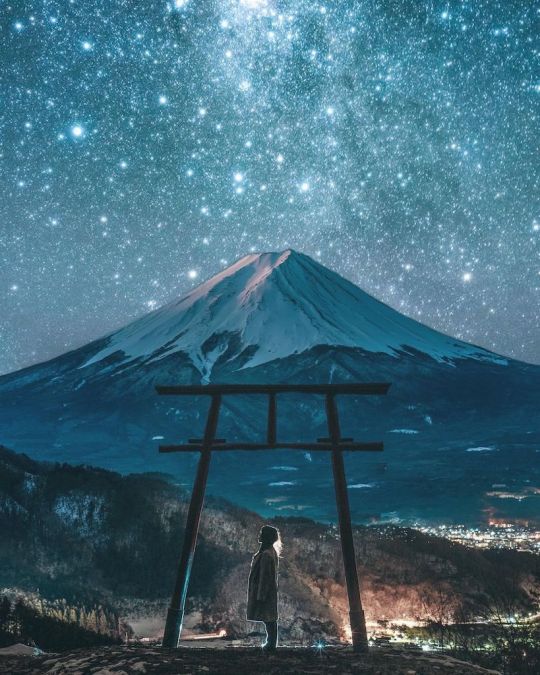
Image Credit : @kenkeno215
After a 10-day long devastating eruption of Mount Fuji in 864, Kawaguchi Asama Shinto Shrine was built the following year to worship the goddess of Mount Fuji, Asama no Okami (浅間大神).
Every year, on 25th April and 28th July, the traditional chigo no mai (稚児の舞; children’s dance) is performed to appease the god. Children aged 11 to 12 years old, typically girls, dance in front of the shrine to the tune of flutes.
2. Shirahige Shrine – Shiga

Image credit: @shirahigesup
Situated in Lake Biwa, the largest freshwater lake in Japan. Shirahige Shrine is dedicated to Sarutahiko of Mikoto, the god of longevity.
After sunset, the torii gate is lit up for 2 hours on weekends and even longer on special days such as New Year’s Eve.
3. Futami Okitama Shrine – Ise

Image credit: @kenken710
Popular among newlyweds and couples, Futami Okitama Shrine is the place to be for those seeking blessings in their love life and marriage.
The Meoto Iwa (夫婦岩), or “wedded rocks” are inseparable pair of rocks – the big one representing the husband and the small one the wife – are connected by a shimenawa (sacred rice straw rope).
4. Motonosumi Shrine – Yamaguchi
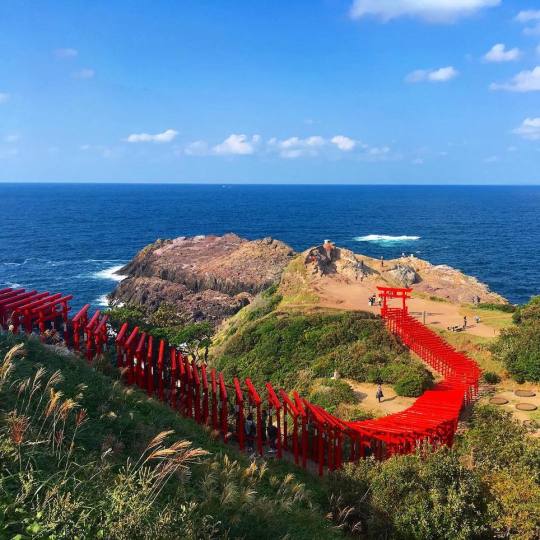
Image credit: @muracome
Legend has it that in 1955, the spirit of a white fox instructed a local to build a shrine. Obliging the deity’s request, the man built and lined 123 red torii gates along the edge of a cliff.
Today, the shrine attracts visitors who are hoping to pray for wealth, studies, pregnancy, and even fishing.
5. Takaya Shrine – Kagawa
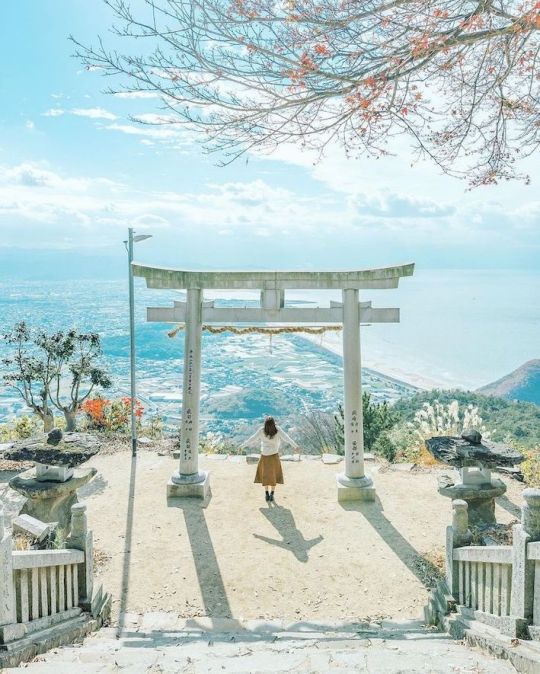
Image credit: @mitwo_310_dayo
Dubbed the “torii in the sky”, Takaya Shrine in Kagawa Prefecture sits atop the 404m-tall Mount Inazumi. The torii gate of the main shrine overlooks a panoramic view of the city of Kanonji and Seto Inland Sea.
6. Sakurai Futamigaura – Fukuoka

Image credit: @sai_._ias
While the Meoto Iwa in Ise is better known for its sunrise views, travellers flock to Sakurai Futamigaura in Fukuoka to watch the sun set.
Every May, a ceremony is held during low tide to change the shimenawa. As the rope measures over 30m in length – almost half the width of a football field – and weighs over 900kg, as many as 50 people are mobilized for the switch.
7. Udo Shrine – Miyazaki

Image credit: @tate.masa
The cliffside Udo Shrine is perched on the rocky Nichinan Coast, south of Miyazaki City, surrounded by magnificent waves.
Legend has it that Toyotama-hime, a goddess of the dragons and sea, went into labour on land. A maternity hall was built in a hurry, in a sacred cave, and Toyotama-hime gave birth to Ugayafukiaezu no Mikoto, who was later enshrined as a deity.
Today, the birthplace is better known as the main shrine of Udo Shrine. Thanks to its history, a visit to the shrine is considered to be beneficial for couples trying to conceive, and expecting mothers praying for a safe pregnancy.
8. Amano Iwato Shrine – Miyazaki

Image credit: @nobphotoo
According to Japanese mythology, the sun goddess Amaterasu hid in this cave after a destructive battle with her brother. Refusing to come out of the cave, her isolation cast darkness over the world. It was only when the other gods and goddesses came together to devise a plan that Amaterasu was lured out, returning light to the world.
The period between November to February is the prime time to visit as that’s when the annual Takachiho Kagura – a shinto ritual consisting of festive folk dances – is held. The main event is held on 22nd and 23rd November, but the dances are performed every night between November and February.
9. Kuratake Shrine – Kumamoto

Image credit: @ryh.photo
The remote shrine was built to protect the sea and to pray for the safety of fishermen. For that reason, you’ll find a ship-shaped vessel filled with empty shells of mina, a shellfish native to the sea of Amakusa, in front of the shrine.
Due to a flood in 1972, the mountain trail was closed to the public and only reopened in 2012. As a result, the shrine completely went under the radar, privy to only the most savvy of locals and budding photographers.
10. Naminoue Shrine – Naha
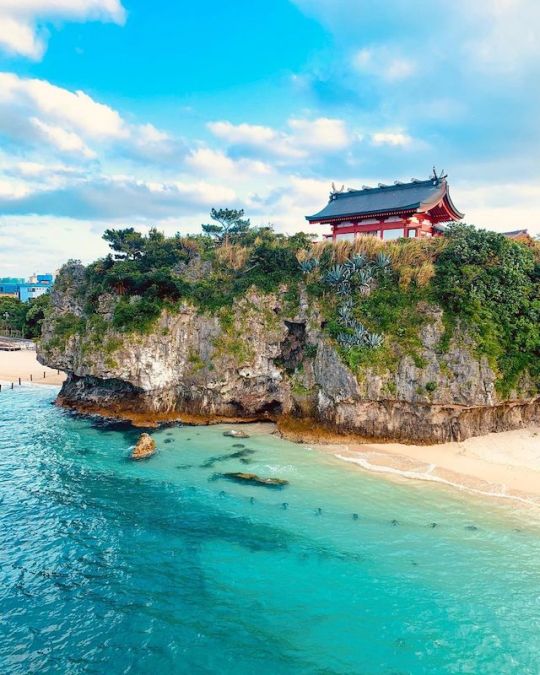
Image credit: @cliff511299
As the most prestigious shrine in Okinawa, Naminoue Shrine is widely revered as one of the 8 special Ryukyu shrines since the Ryukyu Kingdom era.
Affectionately nicknamed “Nanmin-san” by Okinawan natives, Naminoue Shrine is a power spot that can grant blessings for everything, from matchmaking to pest control. The date of the shrine’s founding is unknown, but it is believed that the roots can be traced back to when locals prayed to Nirai Kanai (ニライカナイ) – god’s world in the distance of the sea – for abundant harvests.
#underrated places in japan#kawaguchi asama shrine#yamanashi#mount fuji#shirahige shrine#shiga prefecture#lake biwa#futami okitama shrine#ise#motonosumi shrine#yamaguchi#takaya shrine#kagawa#sakurai futamigaura#fukuoka#udo shrine#miyazaki#amano iwato shrine#kuratake shrine#kumamoto#naminoue shrine#naha#okinawa#kyushu#shikoku#chugoku#kansai#chubu#japan#shinto shrine
14 notes
·
View notes
Text
Mugen: The Embodiment of Shintoism’s Redemptive Delinquent, Susanoo-no-Mikoto
Before I get into this Samurai Champloo analysis, I first want to make this clear that this is all interpretations I have made. There’s no actual direct information about the Shinto stuff (that I’ve seen), but I found a lot of parallels. There’s also a lot of variations in Shinto myth! So you may find some different but similar details.
To begin, one would at first think Mugen would be a representation of Amaterasu, Kami of the Sun, because of his association with red, fire, the sun, and the rooster in his title image. (Rooster’s represent the dawn and they were used to lure out Amaterasu from a cave). And in contrast, Jin would be associated with Susanoo, God of the Ocean and Storms, because of his association with water, and the aquatic fish in his title image. However, based on everything I am about to list, it is the exact opposite. Mugen and Jin are supposed to be like Yin and Yang, their elements canceling each other out. However, the two do possess traits of one another. For Mugen, it’s Jin’s samurai honor and morality. For Jin, he has Mugen’s stubbornness to not follow those he considers unworthy.
Mugen and Susanoo’s Personalities
Susanoo in his earliest myths, is seen in an extremely negative light. He is violent, rude, wild, arrogant, and loathed by the other Kami for his impulsive actions. In particular, his older sibling Amaterasu despises him. She by comparison, is benevolent and calm. He is the embodiment of chaos in stark contrast to his sister who represents “the balance of the universe”. Susanoo’s appearance is also supposed to be disheveled.
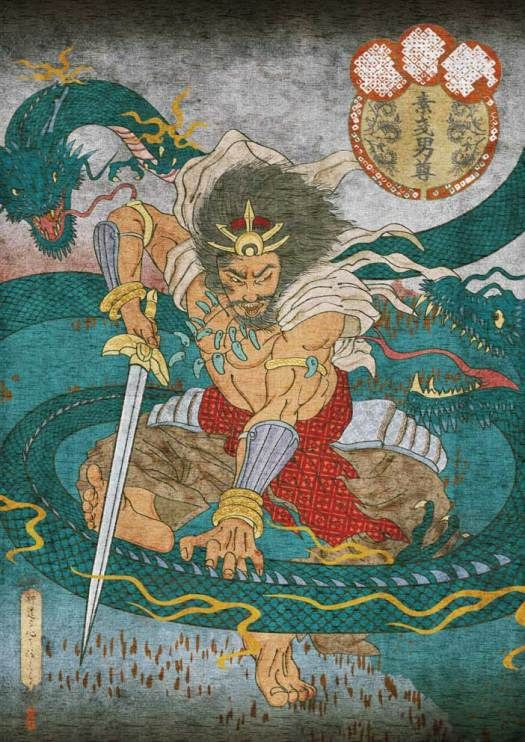
Susanoo, along with his two siblings, were born after his father Izanagi cleansed his face, after visiting the polluted underworld known as Yomi.
But...while Amaterasu and Tsukuyomi were born from Izanagi’s eyes, Susanoo was born from Izanagi’s nose last. The Kami believe that Susanoo had already absorbed some of the impurities of the underworld, and was tainted at birth.
This idea of being “lesser” fits very much in how Mugen is treated by society. The Ryukyuan people were heavily subjugated and experienced severe discrimination by the Japanese.
Ocean And Storms Symbolism
Susanoo is most notably the Kami of the Ocean, Storms (particularly rainfall) and Harvest (also because of rainfall). Later though, he ends up becoming the Kami associated with Love and Marriage. This will be explained further later.
Mugen has a heavy affiliation with the ocean, because of his previous occupation as a pirate and being born and raised in the penal colony island known as Taramashima which is near Miyakoshima in the Ryukyus. It’s the circular island on the bottom left, below.
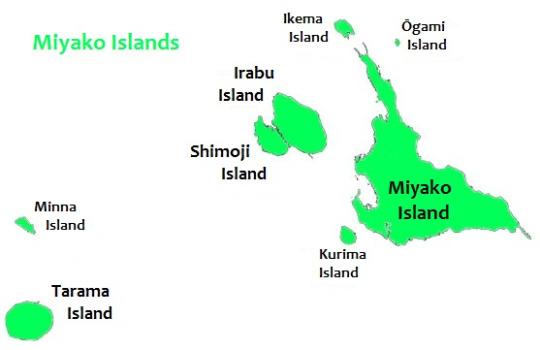
We know Mugen is from here because the black figures that try to send him to the afterlife are known as Paantu. Paantu are deities from a Miyako Island festival that cast out evil spirits by throwing sacred mud on houses and people. In addition, Taramashima was used as a penal colony for Ryukyuan criminals during this time period, and is affiliated with Miyakoshima since it is so close by.
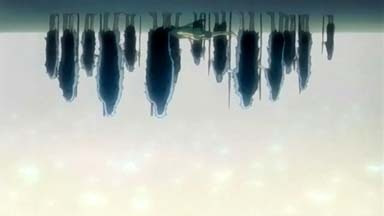
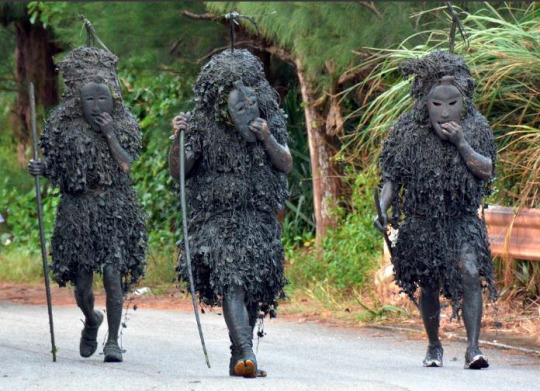
Also, in one of his most defining moments, he swims and emerges from the ocean in episode 25 to save Fuu.
More interestingly, Mugen is definitely associated with storms and typhoons (heavy tropic storm).
The Ryukyuan Islands have a long association with typhoons, because they were so common there throughout history, causing much damage and famine. In World War II, the Battle of Okinawa, known as the bloodiest Pacific battle, was called “The Typhoon of Steel”. In 1972, Okinawa made the flower of the coral tree or the “deigo”, their prefectural flower.
These flowers can be seen in episode 14, during Mugen’s flashback.
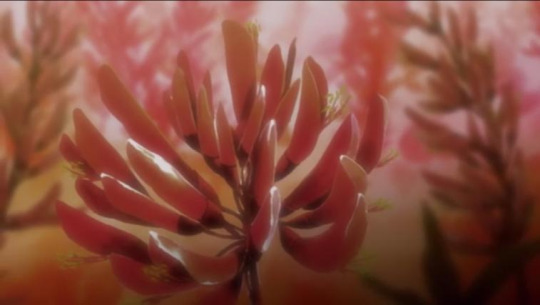

What is interesting...is deigo flowers are a symbol of disaster or catastrophe, namely typhoons. There is an Okinawan belief that the more deigo flowers bloom, the more typhoons there will be. In this episode, which is all about Mugen’s past, we are given double symbolism of the ocean and storms, when he nearly drowns during a severe rainstorm.
In addition, while Mugen’s sword is never named in the anime or manga, his blade is called “Typhoon Swell” in the Samurai Champloo: Sidetracked PS2 video game.
Fall From Grace and Rivalry with Amaterasu
Because of Susanoo’s bad attitude, chaotic personality, and destructive nature, Izanagi, chief of the Gods deemed Susanoo unworthy to live in the Heavens. So he was banished.
Accepting his fate, Susanoo decided to visit his sister Amaterasu before his departure, who had long been his rival that he fought with often.This is largely because Amaterasu as Izanagi’s first child, had divine right to rule, while Susanoo was the youngest and was believed to have impurities. Their rivalry is a symbolism of sunshine versus rain. Both are needed for the harvest, but too much of either causes famine.
This sounds a lot like Mugen and Jin, who cancel each other out.
When Susanoo went to see Amaterasu, the lands shook, and Amaterasu grew suspicious he was causing trouble, so she met him dressed in men’s clothing and in armor. To prove he had good intentions in saying farewell, Susanoo challenged her to a contest of who could create the most gods, in order to prove his sincerity.
Amaterasu took his sword, and broke it, forming three male kami. Susano took her necklace and broke it, forming 5 female kami from the magatama beads. There’s some variations to who exactly won. One says that Susano raged happily since he made more. Another says Amaterasu used trickery, and told him that the 5 female goddesses belonged to her, since they were made from her necklace and the 3 male gods were his since they came from his broken sword. This then infuriated him.
This is similar to how Mugen and Jin broke each other’s swords in episode 26, and neither really won.
Either way, Susanoo went wild, either from rage or pride and committed several heinous deeds, namely destroying Amaterasu’s rice fields and defecating in her palace. He also flayed and killed a holy horse and threw it at Amaterasu’s holy loom, which killed one of her servants.
The holy horse seems to be important to me.
Mugen’s last antagonist of the series are the three Satsuma brothers. In particular, Umanousuke is his biggest enemy who had kidnapped Fuu, tied her to a cross, and brutally tortured Mugen after he gave up his sword to free her. I am no expert, but from what I can gather, “nousuke” in a name, means second in command beneath a lord. And “Uma” means “horse”.
After his belligerent acts, Susanoo was then thrown from the Heavens to inhabit the earthly plane, which is considered to be Japan. Similarly, after Mugen’s pirating in Satsuma, that negatively impacted Umanousuke and his brothers, Mugen finally made it to Japan.
Susanoo and Mugen’s Redemption: Saving a Woman
Despite having been seen as a wild and evil God, there is one story that redeems him, showing him as heroic, and also allows him to reconcile with his sibling.
After Susanoo was cast out of the Heavens, he walked the lands of Japan. This is similar to Mugen being shunned by society for his astigmatism of his prison tattoos, as well as being an illegal alien in Japan, since he hails from the Ryukyuan Kingdom, which at this time period, is in a very complicated relationship between China and Japan.
It is while Susanoo is in the land of man, that he for the first time, is shown actually caring for another person: a young girl.
In his travels, he meets a sorrowful, elderly man and woman who are weeping over their daughter. Susanoo curiously asks why they are crying.

They tell him that they have lost seven of their daughters to a sea serpent named Yamata-no-Orochi (8 forked serpent) who has devoured them year after year. Now, it is time for the sea serpent to devour their last and youngest daughter: Kushinadahime.
In an uncharacteristic act of sympathy, Susanoo offers to help them. He tells the old couple to give him their daughter so he can protect her.
Upon entering the teahouse of episode 1, which was owned by an elderly couple...Mugen meets Fuu for the first time and saves her.
Susanoo transforms Kushinadahime into a small comb and hides her in his hair so that the serpent can not find her. Then, he goes off to kill the giant snake. He gets the serpent drunk off of very strong sake, and slays it.

From the serpent’s tail, Susanoo acquires the Ame-no-Murakumo-no-Tsurugi (the sword of gathering clouds). This sword has come to represent virtue.

After saving the girl, Susanoo asks her father for the girl’s hand in marriage. And then, after this, it would seem his new wife had tamed his tumultuous heart. She becomes venerated as the Kami of Rice and bears his 5 children. Many temples and festivals honor them together to this very day!

It is after this point, that Susanoo is no longer seen merely as the violent, antagonistic god of storms. He also becomes venerated as the God of Love and Marriage because of his heroism and love for the girl he saved.
A violent, belligerent sinful killer who falls from grace...who is redeemed by protecting a woman and becoming a hero...
You probably see where I’m going with this. Mugen and Fuu are heavily implied to have a subtle romance in the series. But if you’re confused by this and need sufficient evidence, please let me know and I’ll provide my many posts that explain it in detail. I will merely bring up one scene here, in order to tie Mugen’s connection with Susanoo, who has become the God of Love.
In episode 21, Sara tells Mugen “Powerful hatred and rage swirl within you. I cannot tell if it is sadness. It is as if you have never once been loved.”
When Mugen falls to the ground, and Sara readies her blade to kill him, Fuu jumps across his body to shield him from Sara, and begs her not to kill him. In this moment, Sara gasps, and spares Mugen’s life. In this moment, she realizes she was wrong. There is one person who does love him, enough to put her own life at risk.
This is very similar to Susanoo. Up until the point of saving Kushinadahime, he was hated by all the Gods, including his own family. But when he saved her life, she married him, implying her appreciation and love for him.
“In Search of New Lands, I Build a New House”
Immediately after marrying Kushidahime, the lovers travel around Izumi before they can find a suitable place to live. Upon arriving in Suga, Susanoo happily states "Coming to this place, my heart is refreshed.” and then built a lovely palace for him and his wife. Upon its completion, Susanoo composed a song.
The many-fenced palace of IDUMO:
“Of the many clouds rising—
To dwell there with my spouse
Do I build a many-fenced palace
Ah, that many-fenced palace!”
In Episode 14, during Mugen’s flashbacks, a folk song called “Obokeuri Eeumi” plays. Because it is possibly Ryukyuan (or from Kyushu) , and also deals heavily with poverty, and being unable to sustain one’s family, it is safe to say the perspective could be Mugen’s. It is especially important that the very last image he sees when the last lyric of the song plays is Fuu’s face. This last lyric is about the narrator’s lover.
Obokeuri Eeumi (Obtain Our Bearings):
In search of new lands, I build a new house
I thatch the house with reed stalks, gathered neatly in bundles. I thatch the house with reed stalks, gathered neatly in bundles.
At the stone wall, let us celebrate the golden house, that was built by a hundred carpenters. At the stone wall, let us celebrate the golden house, that was built by a hundred carpenters. Let us celebrate the golden house, that was built by a hundred carpenters.
August is fast approaching, and yet I have nothing to wear I want to dress up, so brother, will you lend me just one sleeve?
I wish to dress my children and loved ones… in the one kimono that I own.
As for me, I will wear vines… that I plucked deep in the mountains.
The light of the harvest moon shines down, illuminating the world with its divine light.
When my lover sneaks in to visit me, I wish that the clouds would hide that light just a little.
Both songs are about building a house to live in with one’s loved ones, with a mention of encroaching clouds. Because Susanoo composed his song, and Obokeuri Eeumi specifically plays for Mugen’s near death experience, these songs are reflections of their characters.
Making Amends With the Rival
At some point, before or after building his home, he visits Amaterasu, his long time rival, and offers his sister the sword he acquired from killing the snake, so that the two may finally reconcile. This sword makes up the three Imperial Regalia, along with the Yata no Kagami mirror and the jewel Yasakani no Magatama. After this moment, Amaterasu and Susanoo are no longer bitter enemies, and finally accept one another as siblings.
On the same journey of redemption that Mugen took, in which he saved Fuu time and time again, by the end, Mugen was able to reconcile with his longtime rival, Jin.
More Minor Amaterasu and Jin Symbolisms
It is from Amaterasu that all Japanese emperors claim descent. For that reason, she is the embodiment of the Japanese people. I think this is very similar to Jin, who is a representation of the ideal Japanese samurai with all of its virtues.
When Amaterasu fled from the heavens because of Susanoo’s many insults, the world became a dark and stormy place, because there was no longer any sun. Amaterasu did not want to leave the cave as she grieved for the servant Susanoo had killed. Though it might be reaching, I saw this very comparable to episode 11 of Samurai Champloo, where the trio were stranded in Hamamatsu with perpetual rain. Here, Jin states “I hope that the rain will never stop. Then, I can stay here forever.” when in reference to staying with Shino.
Amaterasu was also insulted by her husband Tsukuyomi for killing her friend, the Kami of Food, and thus never saw him again. This is a representation of the Day and Night cycle, since Tsukuyomi is the Kami of the Moon. I found this similar to Jin having to part from Shino for three years because of her stay at the Divorce Temple. In addition to that, he met with her at night when he purchased her at the brothel. But when the morning came, she told him it was “time for the fairytale to come to an end.”
When Jin parts ways with Shino, the bridge they met on is shown one last time. Except this time, there is no more rain. There is only sunlight.
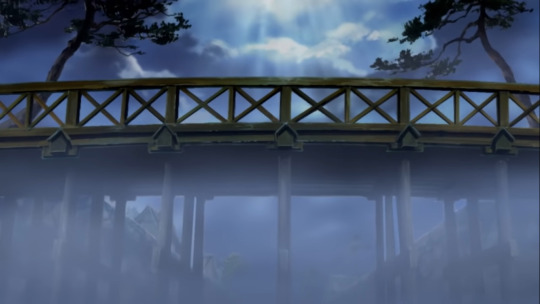
This is a representation that he must continue on his own journey for the samurai who smells of SUNflowers, for it is his duty, just as Amaterasu reluctantly left her cave at the behest of the other Gods...because it was her responsibility to have the sun rise in the sky again.
In conclusion
Mugen and Susanoo were both hated and considered evil. Both were outcasts. But their chivalrous actions in saving a young girl they cared about redeemed them.
Mugen and Susanoo both had a rival that was their polar opposite, but in the end, the two were able to reconcile and value one another.
(And I found another excuse to ship Fuugen.)
#samurai champloo#mugen samurai champloo#fuugen#anime#susanoo#jin samurai champloo#fuu samurai champloo#shinichiro watanabe
132 notes
·
View notes
Text
PastelPoison’s Witches Story
So I thought of this after I saw a Medieval Warriors M.A.P on “Song of the Witches” by S. J. Tucker and now am finally going to write it down.
I was thinking about witches all over the world, not just Western interpretations of witches and such (I have no idea about modern witches) and had never heard of witches from anywhere but the west and basically this is how my story would go if I had the time to write one.
BTW: I talk about myself a lot but just know that these are my frustrations of being a multi-racial person trying to figure out some of my roots on my own.
Though it wasn’t the first thing I thought of, it’s best for me to write down what the world is like for the sake of organization:
Time period has to sort of make sense (ex. While this is happening in Japan in 1400 AD, that is happening in Europe around the same time)
Attitudes have to make sense (ex. two groups are racist towards each other, female homosexuality is more accepted than male homosexuality, mild sexism)
Demographics have to make sense (ex. no one of African descent is going to be in Japan in 1400 AD [unless it’s our traveling cast of characters] and no one is going to be trans and not looked at like a freak, even by our main cast [tsk, tsk; shame, shame])
Keep in mind: I’m trying to explore what witchcraft is in other cultures so how should I make my characters meet? (ex. slave trade, running away)
-----------------
First thing I think about is my characters and 1) my main one, or at least the one that shares (most of) my cultural background, is Japanese. Before even thinking about this, the most I had ever heard of Japanese witchcraft was about this dog demon in a temple in a Japanese murder-suicide graveyard near Honolulu who bit a Filipino man who got very sick and couldn’t be healed because he wasn’t Japanese. And so I did some of my own research but the most common “witch” I could find were people who hired foxes. There was some mention of snake employers but I could never find any reading material that goes in-depth. Also, I want this character to be a reflection of me, I’m mostly Okinawan (25% Okinawan to 4% Northern Japanese, a very unbalanced ratio) but if I have to make her fully Japanese for the sake of keeping her simple enough I will.
So, “Yuki” is a simple name and a memorable one and I also imagined a picture of Yuki-onna that I saw once whenever I thought of the character so that’s her name for now. And I will alter some stuff in the story as long as I can explain the alteration, so if people don’t turn into animals in the origin story but do in mine, I should be able to explain why I didn’t stick with it, this is basically a fanfic.
Witch by association (has a tsukimono as a familiar/pet) [+also might have it possess her at some point if it fits]
Very close to her family but the relationship with her community is strained due to being slightly wealthier and also being part of a tsukimono-suji. Otou-san is still in charge but Okaa-san is the one that is more than happy to get back at you if you mess with the family business simply because she can get away with it. And letting it be known to any outsiders that there’s a spirit helping out, not that good when you’re looking to support your family. It didn’t help that Obaa-san is from the Ryukyu Kingdom and works with her hands, often exposing the odd tattoos that she wore.
Eventually is the sole survivor of a massacre.
Overall is a neutral character, going her own way, not trying to change or dismantle society (just doesn’t want to be in one)
-------------------
2) The second and third characters I know I want to be European, one female and the other male because the first and second verses of the song are sung by females (I don’t know if it’s another woman or her putting on a different voice, but it’s definitely female) and the last is sung by a guy.
I’ll put the guy down first, his name is... I don’t even got a name for him yet. “Lennox” he used to live in an elm forest, just roll with it.
I had a druid in mind when I was thinking about him but Druids disappeared when the Roman Empire took over so instead he’s a scholar. He knows a lot about astronomy, plants, herbs, law, religion, geography, trying to get him as close to a druid as I can.
He’s from Soctland (whether to have him be Scottish or Irish really tripped me up so just bear with me here). He can speak English and Gaelic.
Overall good guy, wise teacher, oldest member of the group
----------------------
3) The female European. “Minerva”
Basically what first pops into your head whenever you think of a witch.
Looks normal, my vanilla witch. Just your average white girl in whatever time in whatever village.
Doesn’t always have the best intentions and usually has less than stellar results
------------------------
4) The Little African Girl. I don’t really have an official name as she’s more of an idea at the moment than an actual character so I just gave her a title.
Represents regular people who perhaps seeks the help of witches
More of side character as she doesn’t stick with the group but engages in business with them against some sort of tyranny to save her family, community, friend, etc.
-------------------------
5) “Tyranny” S.J. Tucker says in the song that the witches fight against tyranny and I only thought of one character representing tyranny but perhaps there will be multiple forms of tyranny as I expand on this (if I expand on this).
But the one I have in mind so far is the Little African Girl’s rival. Some sort of corrupt leader or evil witch.
-------------------------
6) Others I’ve thought of:
Hawaiian witch (I’ve been surrounded by Hawaiian culture my entire life but have only recently heard of Hawaiian witchcraft. It’s sort of like skinwalkers from what I’m told: the more you talk about the more it comes closer to you. Also in Hawaii: you’re not supposed to outright say that someone’s wrong, they’ve just been taught differently “maika’i” [good/fine/alright] so if I’m writing down too much detail or not enough, hopefully this answer will satisfy you) The forbidden portion is this martial art but every family is tied to the Gods and certain spirits (aumakua).
Gypsies (might be a racist stereotype but I want a crystal ball with a ghost inside it)
Australian Aboriginals (a culture I know nothing about, have only learned about in the last three months, and want to research more of)
Native Americans (again, a culture I know nothing about besides wendigos and skinwalkers)
Voodoo
Also I should mention: sometimes there’s going to be two characters representing the same type of witchcraft but going against each other just to balance everything out.
Sources
Witchcraft in Japan: The Roots of Magical Girls - https://www.cavernacosmica.com/witchcraft-in-japan-the-roots-of-magical-girls/
Encyclopedia of Shinto - Tsukimono - http://eos.kokugakuin.ac.jp/modules/xwords/entry.php?entryID=792
The Yuta, The Noro, and The “Okinawan Witch Trials” - https://www.tofugu.com/japan/yuta-noro-okinawa-witch-trials/
The Romans and the Druids - https://www.historylearningsite.co.uk/ancient-rome/the-romans-and-the-druids/
To be continued?
#my prompts#prompt#fic prompts#witch#witches#japanese witchcraft#tsukimono#songfic#witchcraft#history#historical fiction#fantasy#just roll with it
5 notes
·
View notes
Text
yoooo while looking up stuff on izumo i found this article debunking the idea of japan being a “homogenous” nation and damn it’s interesting :o i mean, ofc i knew about that concept already but i just haven’t read anything that approached it from the “japan has ALWAYS been internally diverse” pov as opposed to tackling it only from the “because of the existence of indigenous ppl/foreign migration” pov. it actually kinda reminded me of our own history, like how there were many distinct countries/kingdoms back then and no singular but nebulous malay “race” (which is actually composed of many ethnic groups).
i’m just gonna save some quotes for my own reference, in case i wanna look further into this next time:
In my research, the term “Yamato Minzoku (people)” did not appear until the year 1888. Following the emergence of the term “Yamato Minzoku (people)”, the term “Izumo Minzoku (people)” also appeared in 1896.
-
After that, the KiKi myth was introduced in schools to justify the Emperor’s rule. However, about 30-40 % of the Kojiki is devoted to the Myth related to Izumo, which says that the emperor’s rule in Japan started when the Izumo gods surrendered their realms to the Yamato gods. Consequently, Meiji historians concluded that there was a country ruled by the Izumo people before the Yamato people came to Japan and that the Izumo were an indigenous people in Japan’s main island. [...]
However, there is another account from the oldest existing book in Japan, from early C.E.700. [...] According to the original Izumo Myth, there is entirely no relation between Okuninushi (Onamuch), Susano or the Sun Goddess. Onamuch, the supreme deity of Izumo myth [...] does not surrender the land of Izumo. He proclaims that he will continue to govern the country of Izumo while entrusting his other lands to the descendants of Amaterasu (the ancestor of the Yamato's king).
The Izumo myth also states that the Izumo gods built the Great Shrine (the oldest and biggest Shinto Shrine in Japan) for Onamuch, contrary to the Yamato myth that Amaterasu built it. The fact that descriptions in Izumo Fudoki are very different from the KiKi has been ignored in Japan’s historical education.
-
Many scholars have pointed out that Izumo religion is different from Ise (Yamato) as the former worships gods that are related to the sea, lakes and rivers (and is thus similar to religion in the Ryukyu (Okinawa) islands) while the latter worships gods related to the sun. It is said that Izumo’s god concept has a horizontal character (the gods come from the sea and have no hierarchy), while Yamato’s has a vertical character (the gods come down from heaven and have a hierarchy structured under Amaterasu who is said to be the ancestor of the Yamato King, emperor).
-
The Izumo ethnic identity is also seen in the “Izumo Nation Study”, written by Tokutani Toyonosuke, in Shimane Hyoron, 1934-1936 (18 issues). In this thesis, he states that “Every time when I met persons from other countries (within Japan) and heard their languages, I noticed they were extremely different from our Izumo language and I felt very strange.” [...] In fact, many authors have even recently asserted that Izumo is very different in history, religion and language from Yamato.
-
In the middle of the 19th century, the present Japanese archipelago (not including Okinawa and Hokkaido) was divided into 68 states and there was no Japanese national identity among ordinary people. Nitta Hitoshi writes in 1999 that “In the Edo period, what was recognized as ‘country’ were domain (han) governed by lords (Daimyo). A Samurai's loyalty was toward their Daimyo, and another domain was a ‘foreign country’. Therefore, even if other domains fought with a European country and lost, they regarded it as a foreign matter that had fundamentally no relation to them.”
-
Kyushu people, in general, tend not to recognize Japan as a homogeneous country not because of the existence of Ainu, Okinawan (Ryukyuan) or Koreans, but because they consider themselves different from the Yamato. My university colleague from Kumamoto, southern Kyushu, once said to me very naturally “I am the Kumaso," a people originally from East China Sea kulturkreis who had resisted Yamato’s aggression until the 7th century.
-
Nishitaka Totsu (1838-1915), an official of the Ministry of Education, wrote in 1873 in the “Ministry of Education Magazine” (文部省雑誌), “The languages of east and west regions are not mutually understandable.” [...] “There is no other country like Japan, whose territory is only 2400km wide from east to west (not including Hokkaido), in which the languages are so different and the people cannot communicate with each other”.
-
“When I took the train from Tokyo to Fukushima, a British man and a woman from Sendai were sitting next to me. The language of the Sendai woman was extremely hard to understand and we could not make conversation at all. On the other hand, I was able to talk with the Britisher a little since I understand a little English.”
-
A famous linguist, Kindaichi Haruhiko wrote in his book “Japanese Language” in 1957 that: If we brought the Kanto, Kansai, Tohoku, Kyushu, Kagoshima and other dialects to Europe, they would be regarded as separate independent languages”. At least, those differences are bigger than the difference between Spanish and Portuguese.
Nishikori Masahiro wrote in 1988 that “Until 20 or 30 years ago, young people (of Izumo) who went to the capital (Tokyo) used to be distressed by a language complex. Now young people can speak the standard language quite well”.
-
Hoshina Koichi wrote in 1898 in his thesis titled Regarding Dialect (方言に就て)that “In order to collect dialects, we have to decide on a language which should be regarded as standard”, “Therefore, we have to take a major language like Kyoto language or Tokyo language and formalize it as the standard one”. We should notice that even at this stage, Kyoto language was considered first. However, Kyoto language did not become the standard language and the Meiji Emperor lost his mother tongue. This fact also implies that the Emperor was not a real sovereign in modern Japan.
So, what is the standard language we are using now? It is an artificial language created in the early 20th century, based on "the words used by an educated middle-class family living in Yamanote area of Tokyo (where bureaucrats gathered)."
-
Sakaiya Taichi, argues in his book “Japan’s Rise and Fall”(日本の盛衰)published in 2002 that during the rapid economic growth era from 1950 to the 1960s, Japan adapted its society to standardized mass production and created the “optimal industrial society”.
In the field of education, they trained human resources (1) to be patient, (2) to be cooperative, (3) to possess common knowledge and skill, but (4) not to display originality or personality. In the field of regional structure, they aimed for the unification of information and culture by concentrating everything around Tokyo.
Thus, the contemporary national consciousness of the Japanese people is rooted in the suppression of an awareness of their own internal diversity.
#ugh i have a whole bunch of other stuff i need to be doing but well..............#whats new..............#-_-#/punches self the face#sotong txt#japanese history
4 notes
·
View notes
Text
watatsumi is uncomfortable
ryukyu kingdom coexisted with japan as two separate nations until japan colonized it, which involved obviously stripping them off their culture and autonomy.
yet the fantasy reinterpretation of ryukyu kingdom voluntarily assimilated with narukami people at the request of their god. the soil of the island is infertile due to enkanomiya sucking the life off it, so they depend on narukami for survival.
worse, because of the famine they convinced orobashi to invade yashiori island, and the shogunate response that ended with the raiden shogun striking orobashi with the musou no hitotachi is entirely watatsumi's fault. yet generations later they still feel resentment over this, so much so they're willing to use delusions (mind u, made out of the remains of their god) to act on this resentment completely aware that delusions drain their life force.
why is the resentment of the fantasy version of a colonized people painted in a self harming light.
ryukyu had their own customs and culture, their religion was more closely tied to shinto, but it was still specifically ryukyu. they were forbidden from even speaking their own language when japan colonized them, so as with other colonized culture some of it was lost to time.
hoyo tried to emulate this with enkanomiya, detaching the loss of culture from its historical parallel of which japan is responsible and blaming it on-- we're not even sure yet what the hell happened to enkanomiya, as to why they fell to the depths of the ocean. i guess we're blaming it on the neglect of the primordial one.
ryukyu always had a matriarchal tradition, priestesses were a high authority in the kingdom, which is where the sangonomiya lineage takes inspiration from, but the royal seats were still filled. the king was worshipped as the child of the sun, and they had a ritual that renew this belief.
yet genshin turns this tradition into an arrogant pursuit of power by the enkanomiya political class, who turn the aritifical sun created by aberaku into a false god and sacrifice children once they become old enough to understand the facade. the sun is a false god the people are fooled into worshipping, and the reinterpretations of the sun ritual are turned into tyrannical corruption.
i dont know much else about ryukyu, i learned bits and pieces while researching something else. i think its pretty unfortunate what hoyo did at best, and pretty malicious at worst. theres no justification to have gone to this length, even if they wanted to avoid the aspect of colonization and turn it into family friendly braindead assimilation, painting enkanomiya as foolish and corrupt and then burden their watatsumi descendants with their sins its inexcusable.
21 notes
·
View notes
Photo
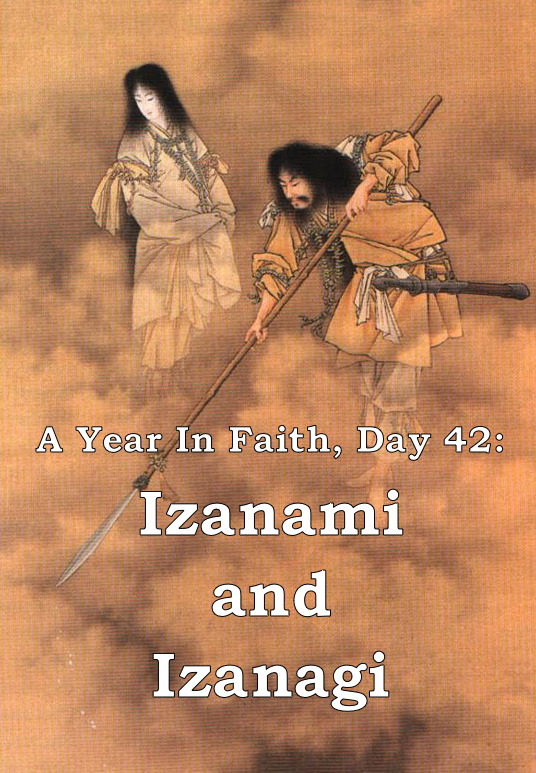
𝗔 𝗬𝗲𝗮𝗿 𝗶𝗻 𝗙𝗮𝗶𝘁𝗵, 𝗗𝗮𝘆 𝟰𝟮: 𝗜𝘇𝗮𝗻𝗮𝗺𝗶 𝗮𝗻𝗱 𝗜𝘇𝗮𝗻𝗮𝗴𝗶
Izanami and Izanagi are a pair of creator gods, or Kami, in Shinto. They are credited with the creation of the Japanese islands and the other Kami. Their names are thought to mean something like “she who invites” and “he who invites”, respectively.
𝗞𝘂𝗻𝗶𝘂𝗺𝗶
The legend of Izanami and Izanagi is recorded in the two oldest classics of Shinto lore, the 𝘒𝘰𝘫𝘪𝘬𝘪 and 𝘕𝘪𝘩𝘰𝘯 𝘚𝘩𝘰𝘬𝘪, both from the 8th century CE. Though Izanami and Izanagi are the progenitors of all the earthly Kami, they are not the first. The first Kami were the mysterious “Kotoamatsukami” who are self-created and without gender. Originally there are three such Kami, but two more come into existence later. After these mysterious and aloof cosmic beings come the seven generations of gods. The exact relationship of these gods to one another is not overtly specified, but from their title as “generations” and the fact that they aren’t counted among the Kotamatsukami, it can be inferred that some among them were brought into existence by the Kotamatsukami and the generated the rest. These seven generations include two generations of singular, genderless Kami and five generations of male/female pairs ending in Izanami and Izanagi. The two young gods are given a mandate by the Kotoamatsukami to create the Earth and are given the heavenly spear Amenonuhoku to do it with. The two stand on the bridge of heaven above the swirling chaotic primordial ocean and plunge the spear into its depths. The salt water that drips from the tip becomes the first land, the quasi-mythical island of Onogoroshima which may be modern day Nushima. On this island they built a palace to live in around a pillar known as the pillar of heaven. When they were ready to procreate, they performed a ritual, each walking around the pillar of heaven in a different direction. When they met, Izanami greeted Izanagi who then greeted her back. The two then had sex and produced a child. This child was not what they had expected. It was born with no limbs or bones, a sad and deformed creature named Hiruko; “Leech Boy”. They put the child in a boat and sent it out to sea. In modern Shinto, Hiruko is said to survive and eventually develops, becoming the lucky god Ebisu. Before that though, Izanami and Izanagi need to figure out what went wrong. The elder Kami inform them that their ritual was amiss as Izanami should not have spoken first. Thus, they perform the ritual again, this time with Izanagi greeting Izanami first. They have sex again and this time give birth to the classical eight islands of Japan (modern Japan contains more, notably Hokkaido and the Ryukyu Islands). This part of the story is called the “Kuniumi”; “Birth of the nation”.
𝗞𝗮𝗺𝗶𝘂𝗺𝗶
Now that there is Earth, or at least the Japanese islands, Izanami and Izanagi must fill it with Kami. This is not difficult as almost every action either of the two progenitors take creates grand lists of Kami in the 𝘒𝘰𝘫𝘪𝘬𝘪 and 𝘕𝘪𝘩𝘰𝘯 𝘚𝘩𝘰𝘬𝘪. This all goes well until Izanami gives birth to the fire Kami Kagutsuchi. Because he is made of flame his birth burns Izanami’s genitals which results in her painful death, though not before more Kami are created from her vomit and urine (as I said, every action creates Kami). Distraught, Izanagi beheads Kagutsuchi, and act which also creates many Kami from the droplets of blood. Izanagi travels to the land of the dead, the subterranean Yomi, to retrieve Izanami. Unfortunately he is late, and Izanami has already eaten the food of Yomi, thus trapping her there. Izanami tells Izanagi she will go barter with the lords of Yomi for her release, but he must not make any light. Izanagi is unable to fulfill this request as he wishes to see the face of his beloved again. Upon lighting a candle Izanagi is met with a horrific sight: the once beautiful Izanami is now a rotting corpse. Horrified, he decides to flee Yomi. This betrayal, on multiple levels, enrages Izanami. From her rotting flesh she creates 8 thunder Kami, or Raijin, and the terrible hag known as Yomotsu-Shikome. Izanagi is narrowly able to escape to the surface and plugs the entrance to Yomi with a boulder. Izanami curses him, stating she will take the lives of 1,000 people every day to Yomi. Izanagi retorts that he will create 1,500 every day. Thus the separation of the underworld and the cycle of life and death are established. There is one final act in this portion of the tale. Inzanagi goes to purify himself with water which naturally creates many Kami. Most notably are the Kami produced when he washes his face. Of the water wiped from his right eye the moon Kami Tsukiyomi is born. From the water wiped of his nose the storm Kami and culture hero Susanoo is born. From the water wiped from his left eye the sun Kami and ancestor of Japan’s Imperial line Amaterasu is born.
Image Credit: Searching the Seas with the Tenkei (天瓊を以て滄海を探るの図), Kabayashi Eitaku, 1880’s
19 notes
·
View notes
Text
Practice Sentence #1
Note: With any language I learn, I occasionally make practice sentences in the language for practice. Because there are so few Okinawan resources out there, I thought I could post some of my practice sentences out there to give you guys something to read to check your understanding (even if I use grammar structures I haven’t explained yet in our main lessons).
ガーナーまーさんどー! 日本うぅてぃ一番好ちなチョコレートやっさ!
ガーナーまーさんどー! にふんうぅてぃいちばんしちなチョコレートやっさ!
Gaanaa maasan doo! Nifun wuti ichiban shichi na chokoreeto yassa!
Ghana is delicious! It’s my favorite chocolate in Japan.
ガーナー・Gaanaa = ガーナ + や
ガーナ・Gaana = Ghana (Both the chocolate brand and the country)
や・Ya = topic particle
まーさん・Maasan = Delicious
日本・にふん・Nifun = Japan (see below)
うぅてぃ・Wuti = particle marking location
一番・いちばん・Ichiban = Number one, Favorite, Best
好ち・しち・Shichi = Like
な・Na = na-adjective particle
チョコレート・Chokoreeto = Chocolate
やん・Yan = state-of-being copula
On Nifun:
Nifun is an Okinawan word meaning “Japan,” but you may have heard of the word 大和・やまとぅ・Yamatu, which also means “Japan.” So, what is the nuance between the words? This is my conclusion based on observations on how yamatu and nifun are used:
大和・やまとぅ・Yamatu — Used to refer to mainland Japan (excluding Okinawa). It is often used to reference Japan when talking about Japan historically, particularly before the reversion of Okinawa to Japan in 1972. Yamatu is also used to talk about “Japanese” things that don’t apply in Okinawa (or the Ryukyu Islands). Things that originate in the mainland that aren’t naturally part of Okinawa use yamatu (specifically, I’m thinking of yamatuguchi, the word for the Japanese language). Yamatunchu refers to a Japanese person of Yamato ethnicity. While yamatu might be less of a loaded word than the Okinawan Japanese term naichi, the geography of what is covered by “yamatu” and what is covered by “naichi” is roughly identical (I’m sure a semantic debate could be made over whether or not Hokkaido fits into either of those two terms or not). However, like naichi, there’s an underlying connotation that yamatu is NOT Okinawa.
日本・にふん・Nifun — Used to refer to Japan as a nation (including Okinawa). It is often used to refer to Japan in the context of nationwide-phenomena (events, culture, experience, etc) or in the context of international relations/events, especially after the reversion of Okinawa to Japan in 1972. Looking at the example sentence here, we can note that the Ghana chocolate bar can be found throughout (the nation of) Japan, from Hokkaido to Yonaguni. Because it can be found nationwide and is not necessarily unique to Yamatu over Uchinaa or Uchinaa over Yamatu, Nifun would be the best word to use. Talking about Japan in the Olympics, nationwide coronavirus statistics, the number of Shinto shrines across the country — All these would be the context to use nifun over yamatu. Especially when talking about modern day Japan, unless you’re specifically talking about mainland Japan in the context where it is important to separate it from the Ryukyu Islands, nifun appears to be the go-to word. 日本人・にふんちゅ・Nifunchu is also a word, referring to a Japanese person - That is, both ethnic Yamato people and ethnic Ryukyuan people. An Okinawan person is uchinaanchu, a Yamato person is a yamatunchu, and both are considered to be nifunchu. That being said, there is no 日本口・にふんぐち・Nifunguchi. The Japanese language is still the language that originated in yamatu that was brought over to Okinawa after the Okinawan language was around and so, the Japanese language is still Yamatuguchi. Now, let’s say in a hypothetical world where Japan wrote official documents in both Japanese Okinawan. For “nationality” (in Japanese, 国籍), the Okinawan version would use Nifun as “Yamatu” is more of an ethnic homeland than it is a politically-existing country for legal citizenship classification.
When talking about “Japan” throughout history, it might be helpful to know when nifun can or cannot applicable.
Before 1609 — ONLY Yamatu
1609-1879 — As the Ryukyu Kingdom was still nominally independent, Yamatu is still the only appropriate word to use here.
1879-1945 — This is a tricky point in time, especially given the cultural changes happening within Okinawa at the time. Though the amount of shared phenomena between Okinawa and mainland Japan during this time period was less as abundant than it is now, Nifun is an option available to you assuming it’s in the correct context though the chances for that context to pop up is lower than if you were talking about Japan today. For example, the term to use for “Japanese casualties” in the Battle of Okinawa, including both Japanese military and Okinawan civilians, might be Nifun.
1945-1972 — As Okinawa was separate from Japan during this time period, Yamatu would be the only appropriate word to use for referencing Japan during this time period.
After 1972 — With Okinawa returned to Japan, when referencing Japan during this time period, Nifun is an option available to you assuming it’s in the correct context.
This was much longer than I expected it to be for a post about how I like chocolate, but I tried to be as thorough as I could here to give the best explanation as to the difference between Yamatu and Nifun. I hope I helped somewhat in that regard. Likewise, I hope other practice sentences can help you in the future.
1 note
·
View note
Text
Nuclear Gypsies (生きてるうちが花なのよ死んだらそれまでよ党宣言), 1985 dir. Azuma Morisaki

status: completed
download here
translation notes (includes spoilers):
・The film’s english title is “Nuclear Gypsies” after the central subject matter, but the Japanese title is, as you may have noticed, much longer. The Romaji reading of the absurdly long title is “Ikiteru uchi ga hana na no yo shindara soko made yo to sengen”, which roughly translates to, “Declaration by the Being Alive is the Best - If You Die, That’s It Party” - “party” meaning a political party or faction. Going even deeper, the way “being alive is the best” is phrased alludes to the Japanese way of saying “silence is golden”, “言わぬが花” (iwanu ga hana), which in itself directly translates to “not saying is a flower”. Saying something is a “flower” in this way means that it’s “the best”, so in another way the first part of the title could be directly translated to “being alive is a flower”.
It is never made explicit why this is the film’s title.
・Rafute is a signature Okinawan dish, usually consisting of cubed pork stewed in awamori (very strong Okinawan alcoholic spirit), soy sauce, dashi and sugar. Nearly all the body parts of a pig are more or less commonly eaten throughout Okinawa, which explains Barbara’s quip about the pig ears.
https://en.wikipedia.org/wiki/Rafute
・The Okinawan song first sung by Shimabukuro (the character almost only seen on screen playing a sanshin and singing) and then referenced several times throughout the movie is “Juku no Haru” 十九の春 (”Spring of My 19th Year”). Commonly misthought of as a traditional Okinawan folk song (perhaps because it was “adapted” from a much older village song whose composer is unknown), the first recording of the song was released in 1972 and has since been one of the most widely known folk songs representative of Okinawa.
Though the lyrics tell a story from multiple perspectives, which make it a bit hard to comprehend, the song is about an older married man who plans to leave his wife for a younger woman from a brothel. The first 3 verses are sung from the perspective of the wife of the older man, and then the 4th and 5th verses are thought to be from the perspective of the man’s younger lover. The film only references the 1st verse and the 4th.
・There are a few things to note when the Captain says “This is the best place in all of Japan. The Peoples’ Republic of Okinawa, settled on the waves”. The first is that he may be referring to the Ryukyu (former name of Okinawa) independence movement, which has been present since the US occupation after WWII; the second is that “settled on the waves” is a play on words from the name of the eatery that Barbara’s family (?) runs, “Nami no Ue” 波の上、or “on the waves”.
・The Eisa festival is one of Okinawa’s biggest annual traditional festivals, held in late summer. https://www.visitokinawa.jp/information/eisa
・”Tokoyo-no-shima” is a mythological place from ancient Japanese folklore which conjures images of a “distant, otherworldly land”, and has the same connotation as “Heaven”, or at times, “Hades”. I believe the name comes from the story of Tokoyo, who sails to far off islands to search for her banished father. “Tokoyo-no-shima” is likely closely related to “Tokoyo-no-kuni”, which is the land beyond the living (like the afterlife, but not really sinister).
・Miyazato making a joke about wrapping things up in old newspaper and exchanging them for tissues refers to an old system in Japan where people could exchange things for tissue/toilet paper.
・Tadashi, an aspiring yakuza underling, refers to Miyazato as “aniki” 兄貴 which is a common way to politely address someone older or above you in rank (sometimes also of the same rank) within yakuza gangs. It translates literally to “(older) brother”, but I have avoided directly translating it to complicate the character relationships.
・A goza mat is a cheap mat made of rush, common in old Japanese houses.
・Kokusai Street (Kokusai-dori) is one of the main streets in downtown Naha, Okinawa.
・Many references are made to a “hanba” 飯場 which can mean a construction camp, bunkhouse or living quarters for workers depending on the context. In Nuclear Gypsies, they refer to the poorly kept living quarters that plant workers live out of, so translations of the term stem from “plant workers’ living quarters”, shortened when necessary.
・Aiko tells the story of how she was named by referring to words used when playing Japanese rock-paper-scissors, “Jan-ken-pon”じゃんけんぽん. I won’t go into the details of the language used in Jan-ken-pon, but the phrase “aiko deshou!”アイコでしょう!is what you say when the first round yields no winners, and so another round is required (usually in quick succession). The phrase “aiko deshou” literally means “it’ll be a tie, won’t it!”, which ties in to Aiko’s story about her name.
・There is a section in the film where Aiko reminisces about all the people she’s met, beginning with the people at the living quarters she was at. The rhythm of her pattern of speech gradually starts to follow a simple possessive grammar that is easy to say in Japanese but difficult to capture in English - for example, “tsume-kami no Takeuchi sensei” 爪噛みの竹内さん puts together the verb/noun - “nail-biting” - with the name of someone - “Mr. Takeuchi”, more or less indicating that the thing that represents that person the most is said verb/noun; an easier example is “Sawa from Shinonome” - “Shinonome no Sawa san”. These get very complicated and Japanese-centric as Aiko goes on, and while I have tried to capture the bizarre nature of her monologue, there is not enough subtitle space to fully translate the multitude of strange expressions she uses to describe all these people, all of them unique. Moreover, her dialogue begins to multiply around 2-3 times and overlap over one another, making it near impossible to transcribe all the things that are being said. Where possible I have included 2 simultaneous dialogue lines in the subtitles, but otherwise I have chosen to only transcribe and translate the lines that can be heard more or less prominently.
・“Distribution of mementos” refers to “katami-wake” 形見分け, a Japanese custom of giving away the belongings of someone that has recently passed away to family members or others close to the deceased.
・A fox’s wedding is a Japanese expression used to describe a sun shower. Where the term “kitsune no yomeiri” 狐の嫁入り is used, I have chosen to leave it in its literal translation rather than translate it as “sun shower”, as later in a pivotal scene where a sun shower happens, the characters refer to it using a different expression.
・At Aiko’s wedding, the “exchanging of nuptial cups” refers to “san-san kudo” 三々九度, a Shinto marriage ritual of exchanging sake cups between a newly wedded couple.
・When Ginko talks to Barbara about Maria’s future, she actually says something along the lines of her “living like a dog who’s being kept alive beyond its useful life”. This somewhat disheartening expression is “kaigoroshi” 飼い殺し in Japanese, whose kanji literally means “killing by owning”. The expression has come to mean someone who is being kept on a payroll despite not being utilized for their skills. I have tried to reflect this in the subtitles.
・When Miyazato mentions “hateful uranium”, the Japanese being spoken is “uraminyumu” 恨みニューム, which is a portmanteau of “urami” 恨み or “grudge, resentment, malice”, and the Japanese pronunciation of uranium. I couldn’t think of any appropriate ways of reflecting this play on words in English, so I have translated it normally.
・I could not find any reference to the Okinawan expression about hands and elbows mentioned by Tamae’s mother at the end of the film, so I’m unsure as to whether it’s real or not. Similarly, I could not locate any references to Shimabukuro’s ominous response “Higan-jirai jishiki, ichigan-jira ishiki”, so I am unable to translate it. It sounds vaguely Buddhist, or it may be some uncommon idiomatic expression - I have no idea, unfortunately. If anyone knows, feel free to get in contact and fill me in - I would love to know!
2 notes
·
View notes
Text
Utaki

Auf Okinawa, besonders hier im zersiedelten Nanjo, gibt es in den Wäldern auf den Bergen unzählbar viele kleine Anbetungsorte.


Als wir unsere Gastgeberin Keiko-san und ihre Nichte Yuno-san ausfragen, ob dies Orte der Shinto-Religion sind, erklären sie uns, dass das mit Shinto nichts zu tun habe, sondern die ureigene Religion der Ryukyu-Inseln ist. Auch der Buddhismus habe damit nichts zu tun. Uns, mit unserer konstrastiernden europäischen Perspektive, fällt es allerdings schwer die Unterschiede zwischen der Religion Okinawas und der japanischen Ur-Religion Shintoismus zu erkennen. Für die Menschen hier besteht dagegen offenbar ein wesentlicher Unterschied. Nicht vergessen ist etwa der Versuch, die Bevölkerung der Insel zum Shinto-Glauben und Beten für den Kaiser zu zwingen. Dies geschah durch das Hirohito-Regime vor und während des Zweiten Weltkriegs, nicht nur auf Okinawa, sondern auch in den besetzten Gebieten von Korea, Taiwan und Festland-China.

In beiden Religionen geht es um die Verehrung der Ahnengeister, sowie Naturgeister. Wobei beides fließend ineinander übergeht. Nach den Überzeugungen der Religion Okinawas stammen alle Menschen von den drei Urgött*innen Utin (Himmel), Jiichi (Erde) und Ryūgū (Ozean) ab. Im Shinto stammt etwa die kaiserliche Familie von der Sonnengöttin Amaterasu ab, es gibt aber ebenfalls einen Erd- und Himmelsgott. In beiden Religionen gibt es eine beliebige Zahl von Naturgeistern, die Flüssen, Bergen oder der See zugeordnet sind. Dabei gibt es auch böse Geister, die man verärgern kann und somit Unglück auf sich zieht. Eine neckische Gestalt aus der Okinawa-Religion sind die Kijimuna, koboldartige Baumgeister, die Schabernack treiben. Den kennen wir bereis aus dem Nanjo-Anime.
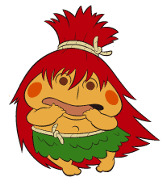
Zwei besondere Geister-Arten der Okinawa-Religion bewohnen jeden Haushalt, der Geist des Herdes, also der Küche (Hinukan) und der Geist der Toilette (Fuuru nu Kami). Letzterer wird gewürdigt, indem man das Bad sauber hält, dafür belohnt er die Familie mit Gesundheit.
Der offensichtlichste Unterschied ist, dass es für die Okinawa-Religion keine Tempel gibt. So gibt es zum Beispiel keine Shinto-Schreine, wie wir ihn in Kagoshima zu Neujahr besucht haben. Es gibt jedoch eine Priesterschaft - die besteht aber ausschließlich aus Frauen, den Yuta. Frauen gelten gemäß der Ryukyu-Religion als besonders empfänglich für die Geisterwelt.

Im Endeffekt handelt es sich beim Shintoismus und der Ryukyu-Religion aber bei beiden um eine Mischung aus alter Natur- und Ahnenreligion, die durch verschiedene Einflüsse, besonders des Buddhismus ähnlich geprägt wurden, sodass man auch die Okinawaer Religion als eine andere Art des Shintoismus begreifen kann.
Aber statt der Schreine gibt es auf Okinawa also diese Utaki ("Heiliger Ort"). Überall an den abgelegeneren Straßen finden sich unscheinbare Pfade oder weniger unscheinbare Betonstufen, die an mystische Orte führen.

Überall wo die Menschen einen besonders prächtigen Baum, eine tiefe Höhle oder einen fantasievollen Felsen finden, haben sie eine besondere Nähe zur Geisterwelt gespürt und diese Utaki errichtet.

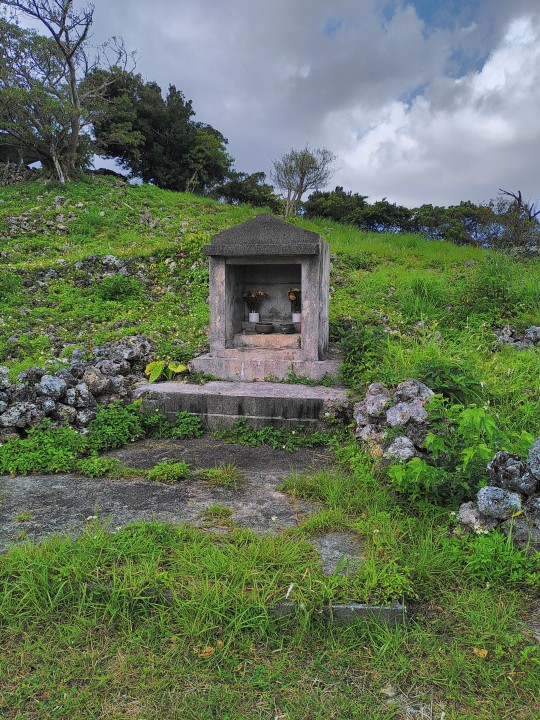
Der Vorteil: Dies sind die einzigen gepflegten Wege durch das undurchringliche Dickicht. Wenn wir uns vor Augen führen wie kompromisslos die Natur sich hier mit wuchernden Schlingpflanzen und steinbrechenden Wurzeln alles zurückholt, bekommen wir auch ein Verständnis für den exzessiven Beton-Einsatz.

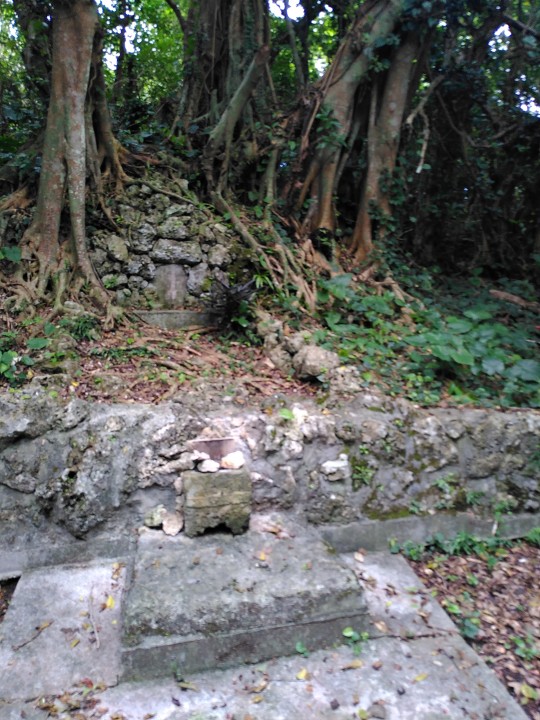


An den Gebetsorten finden sich immer wieder kleine Geschenke an die Kami - die Ahnen- oder Naturgeister. Hier mal ein paar Pappbecher Tee, dort ein paar Münzen und da ein paar… Reissäcke.
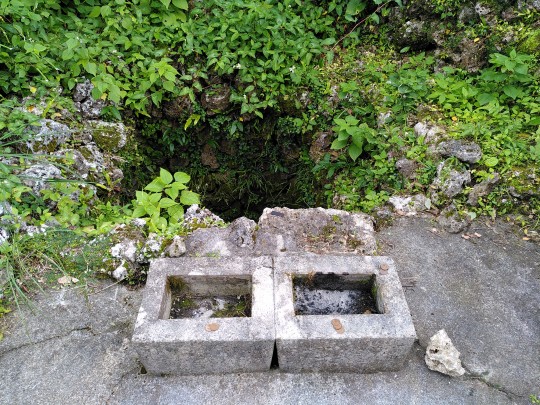


Gläubige Okinawaer*innen besuchen diese Orte um zu beten, zu verlorenen Anghörigen zu sprechen und Rituale durchzuführen. Ein tägliches Ritual ist etwa das Uchatou-mintou, bei dem den Ahnengöttern Tee geopfert wird, um damit die eigene Verbindung zwischen Körper und Geist (Mabui) zu erneuern.
Unsere Gastgeberin erklärt uns allerdings, dass die Religion heute nur noch von wenigen praktiziert wird. Sie ist ein kultureller Bestandteil Okinawas und wird auch gerne bei bestimmen Anlässen genutzt, wie aber auch gleichzeitig buddhistische (z.B. bei Trauerfeiern) und christliche Riten (Hochzeiten) benutzt werden. Das ist ebenfalls etwas, das sehr ähnlich zu Festland-Japan ist. Die strenge Exklusivität, wie wir sie aus den monotheistischen Religionen gewohnt sind ("Es gibt nur einen Gott" / "Du sollst keine anderen Götter neben mir haben") ist der japanischen Religionspraxis fremd.
Die Naturreligion von Okinawa ist in jedem Fall angenehm unaufdringlich und gleichzeitig aufregend mystisch.
1 note
·
View note